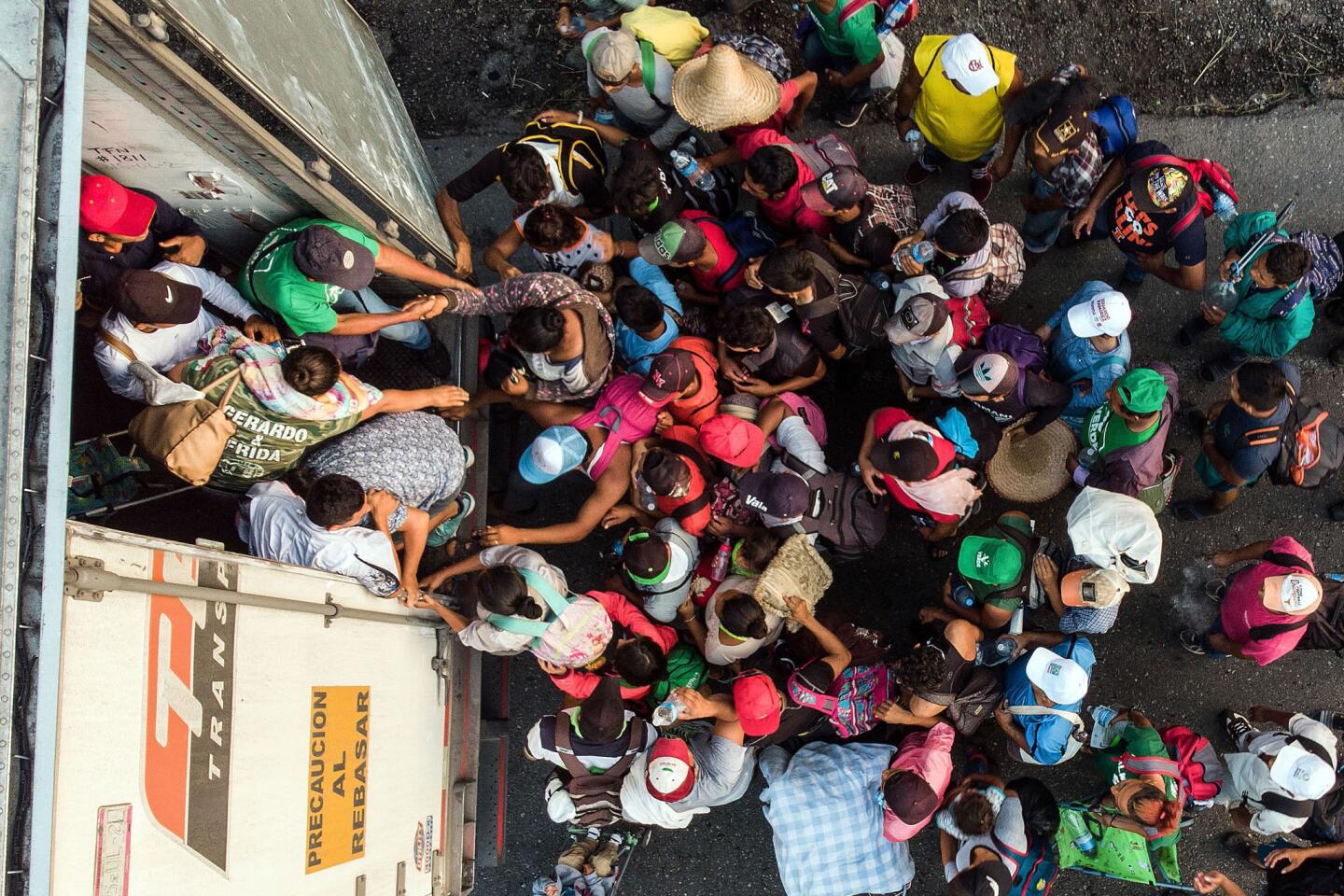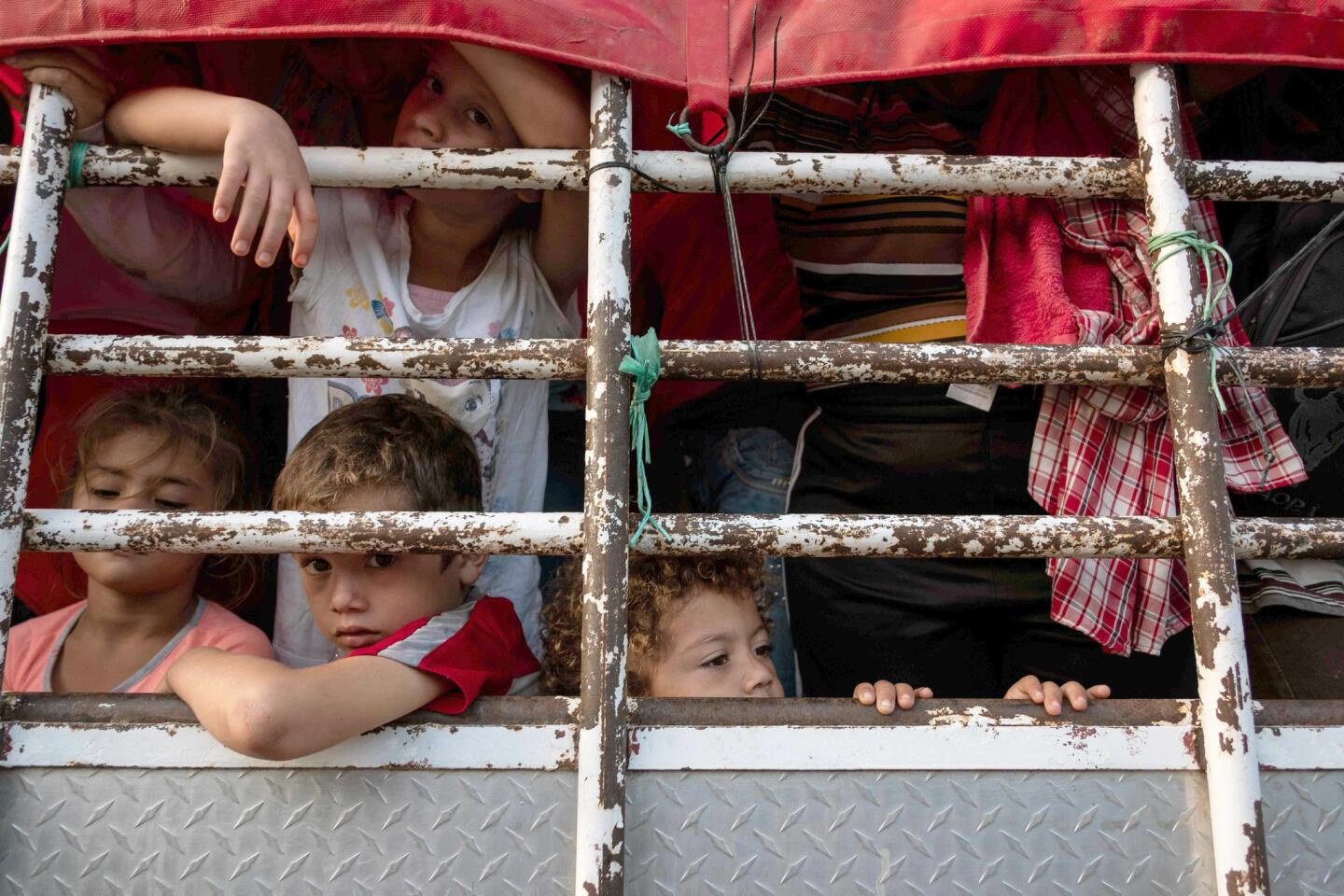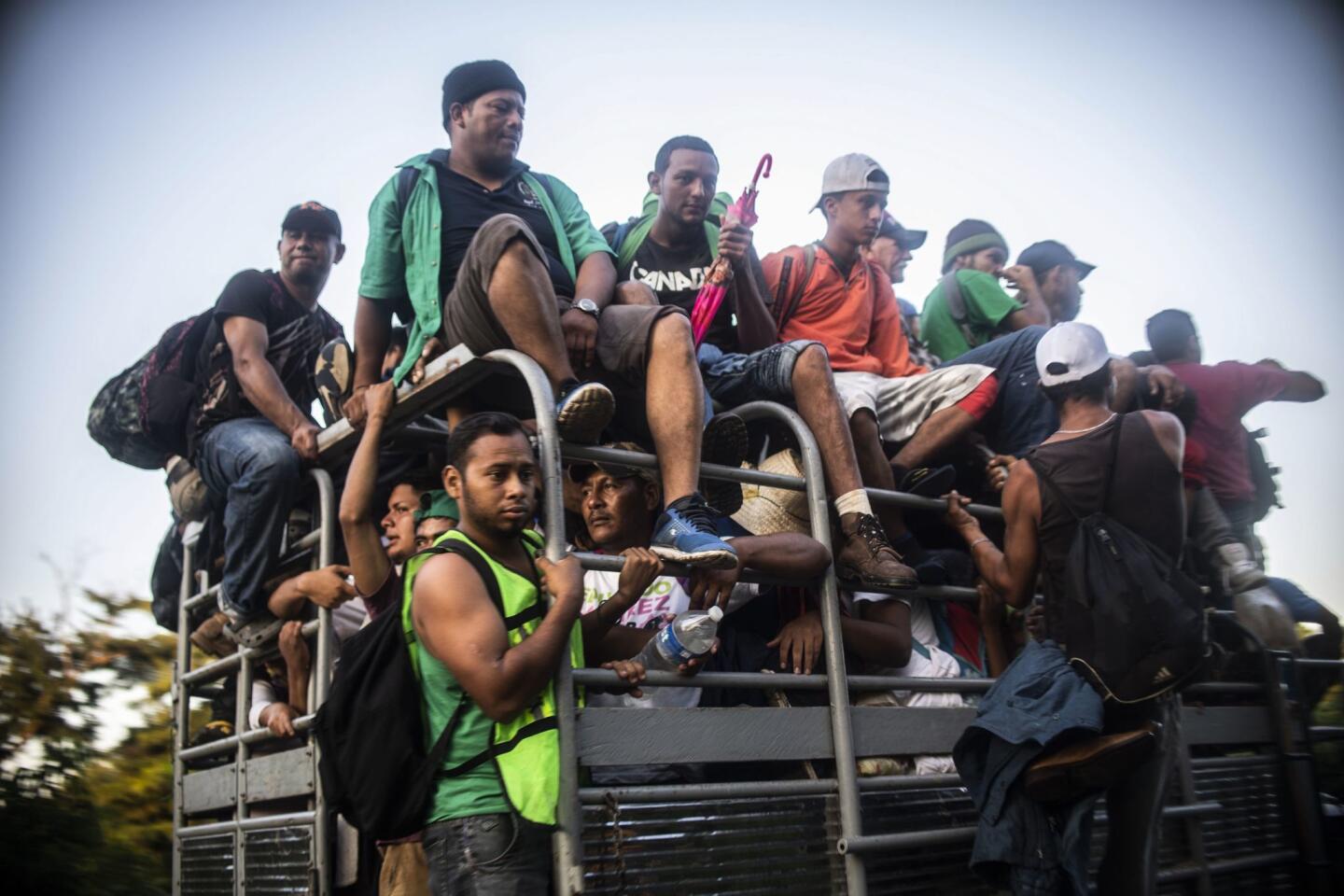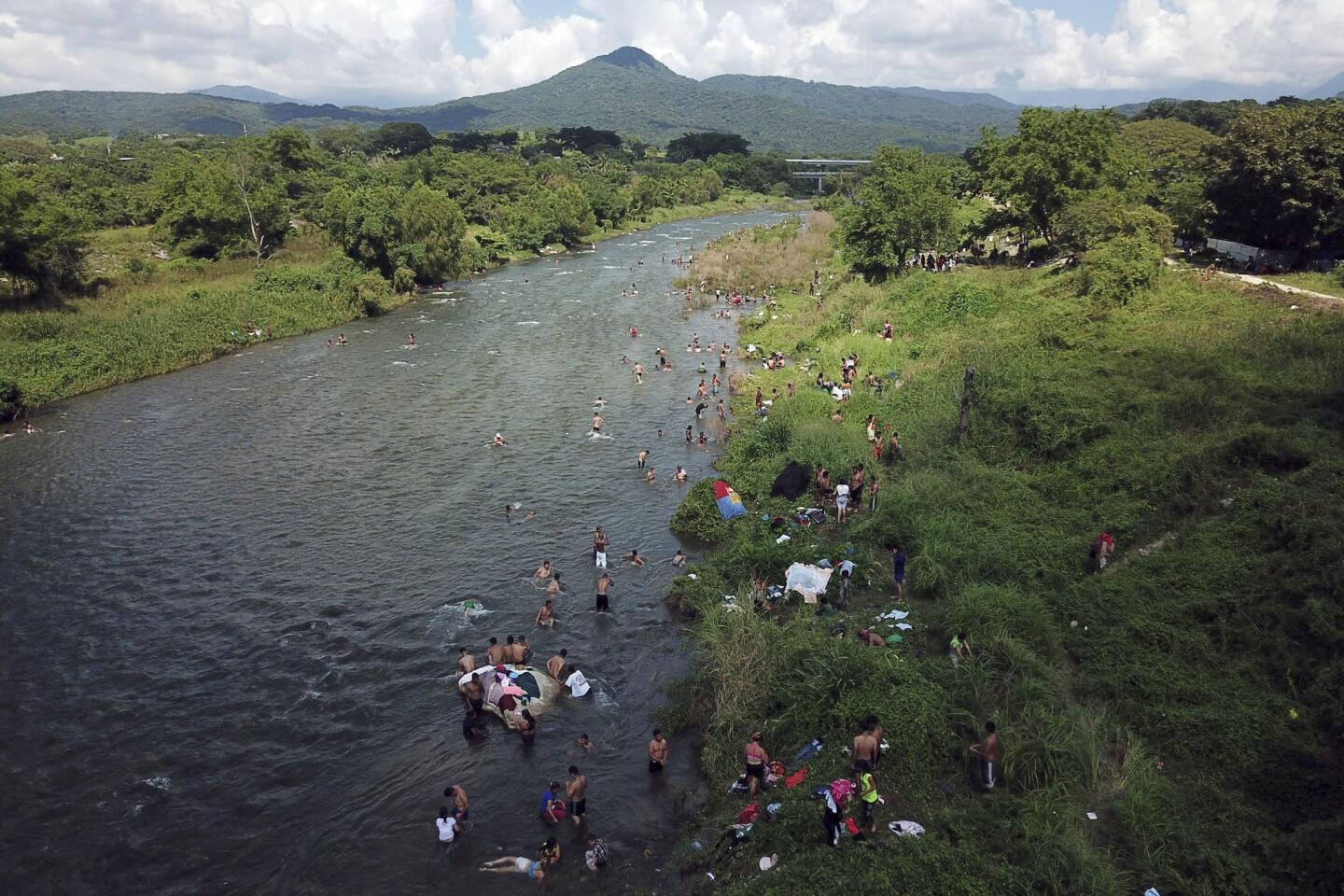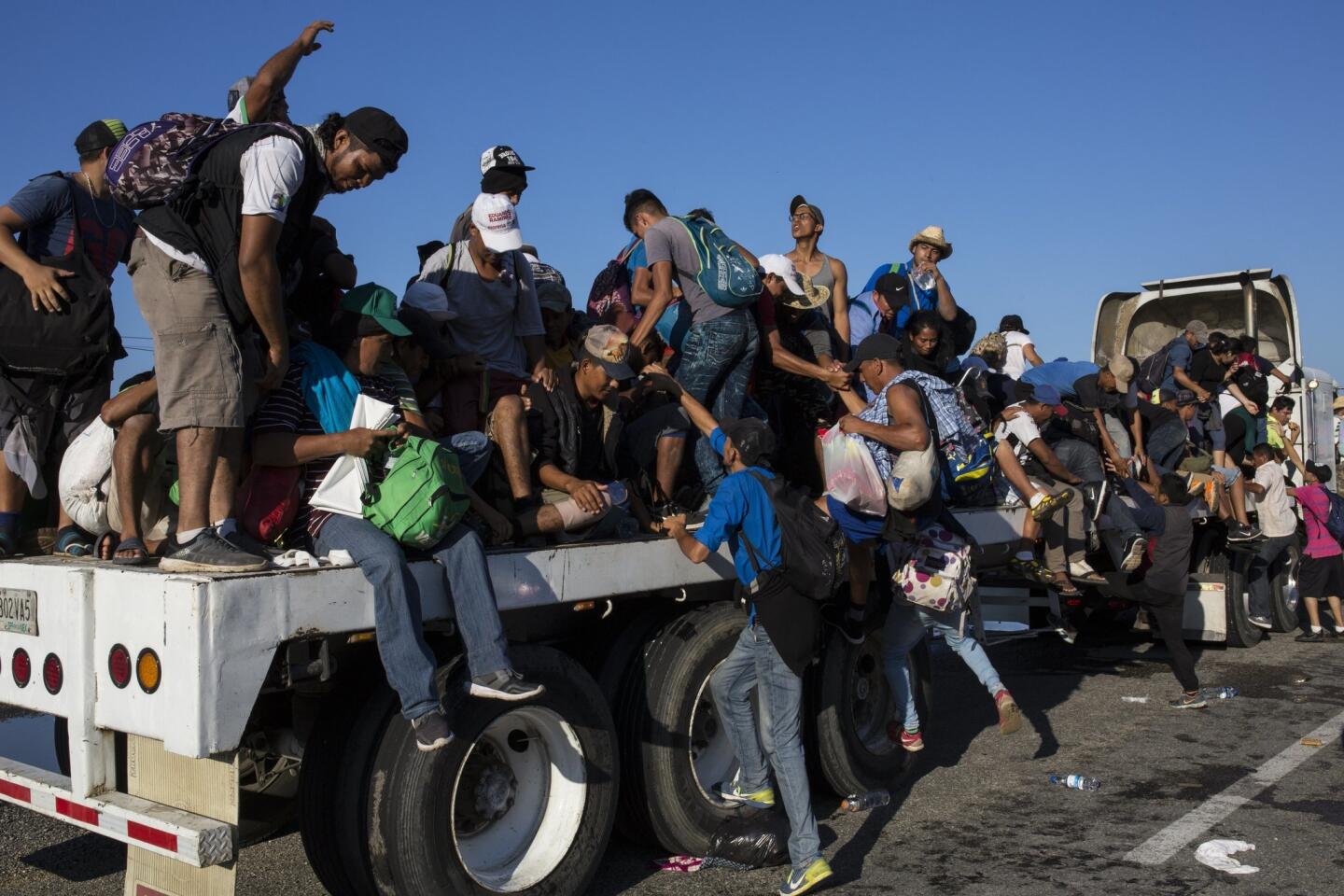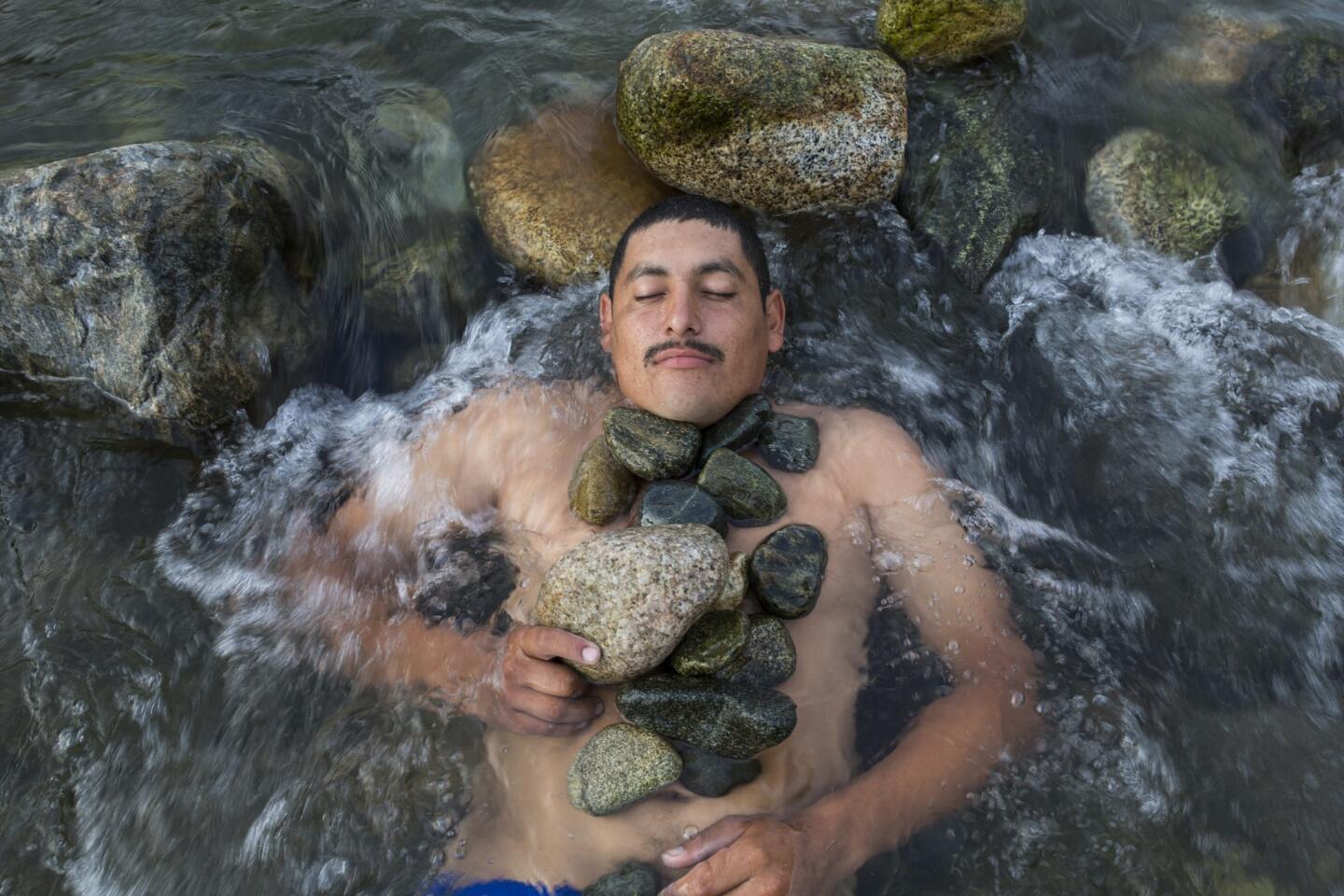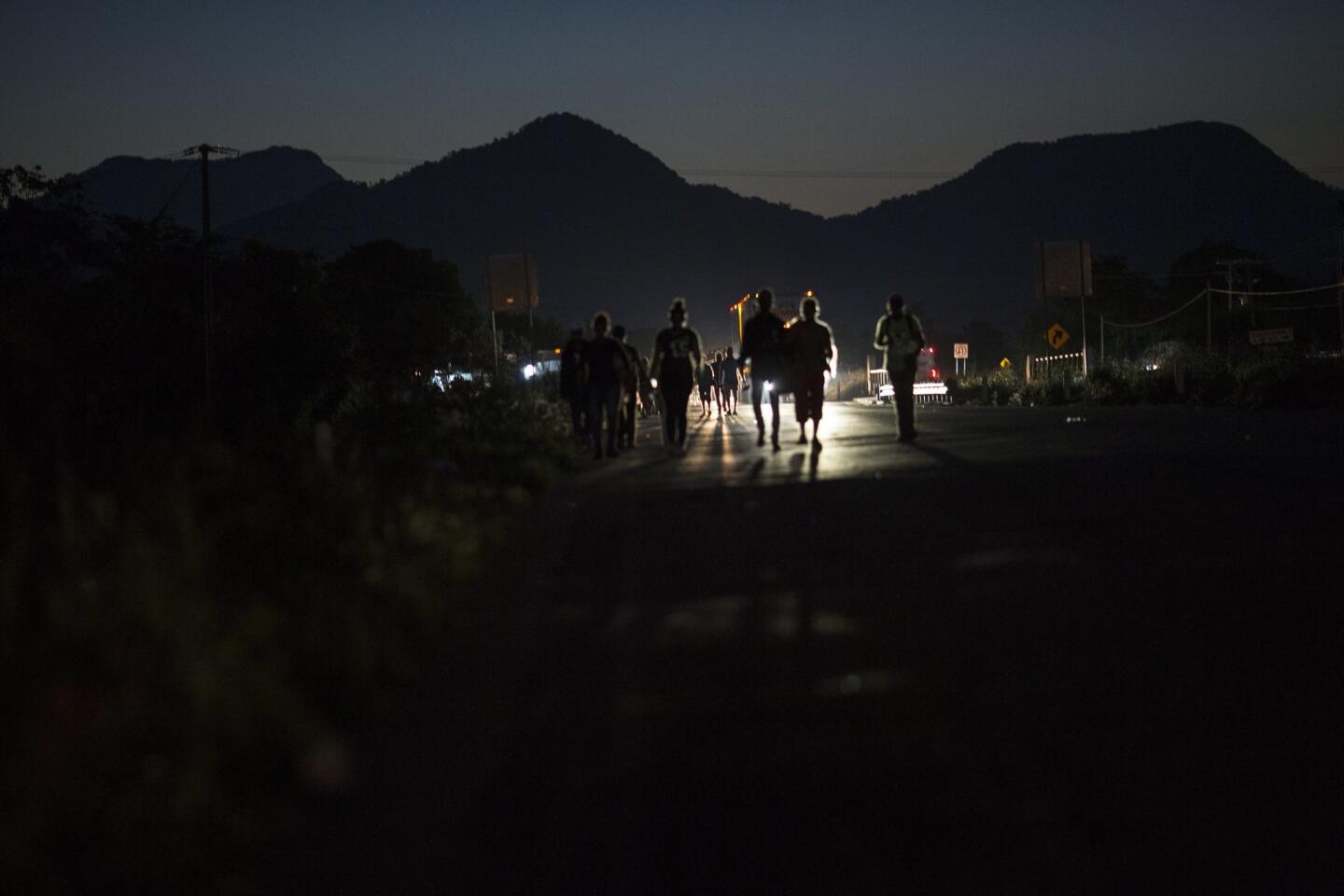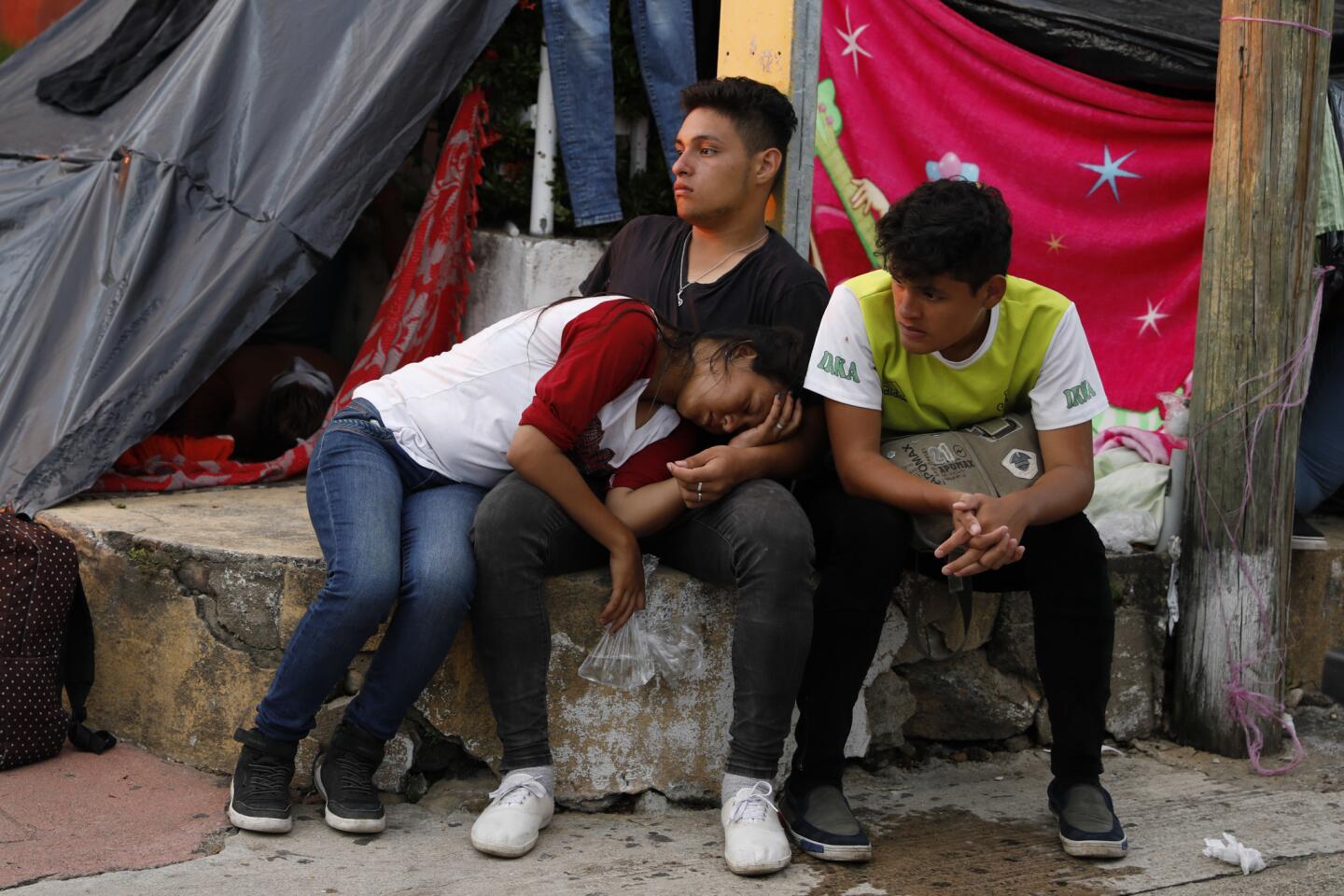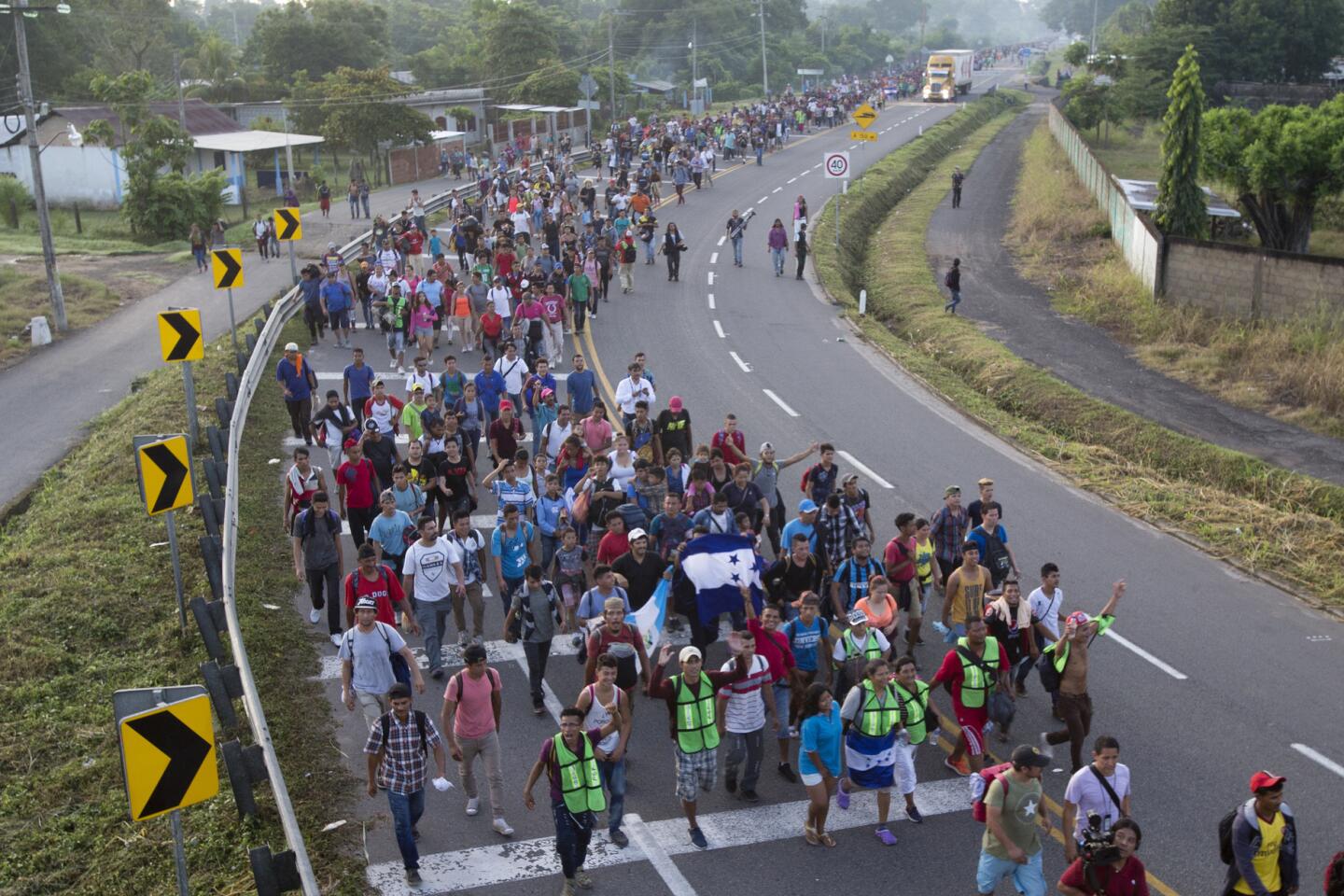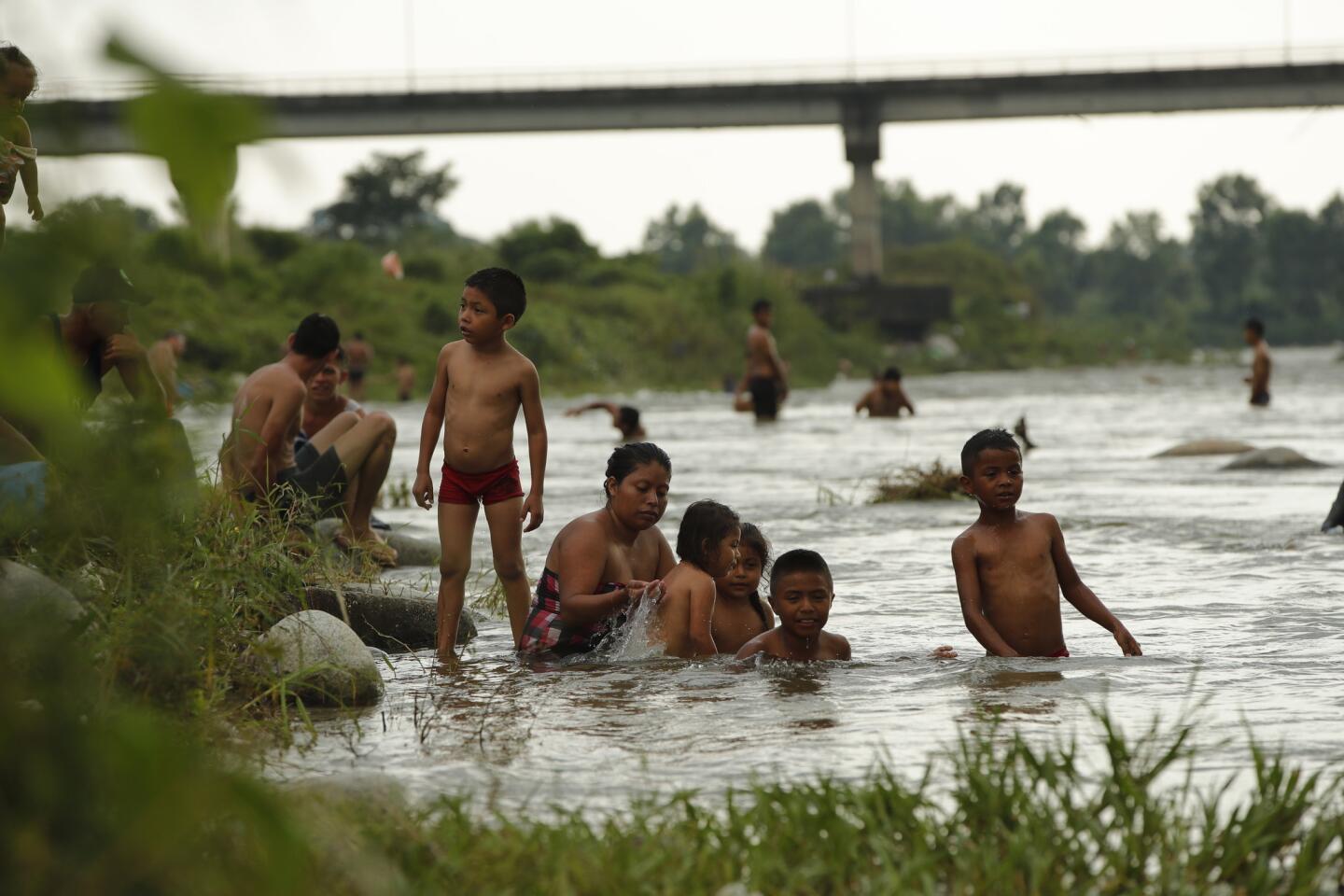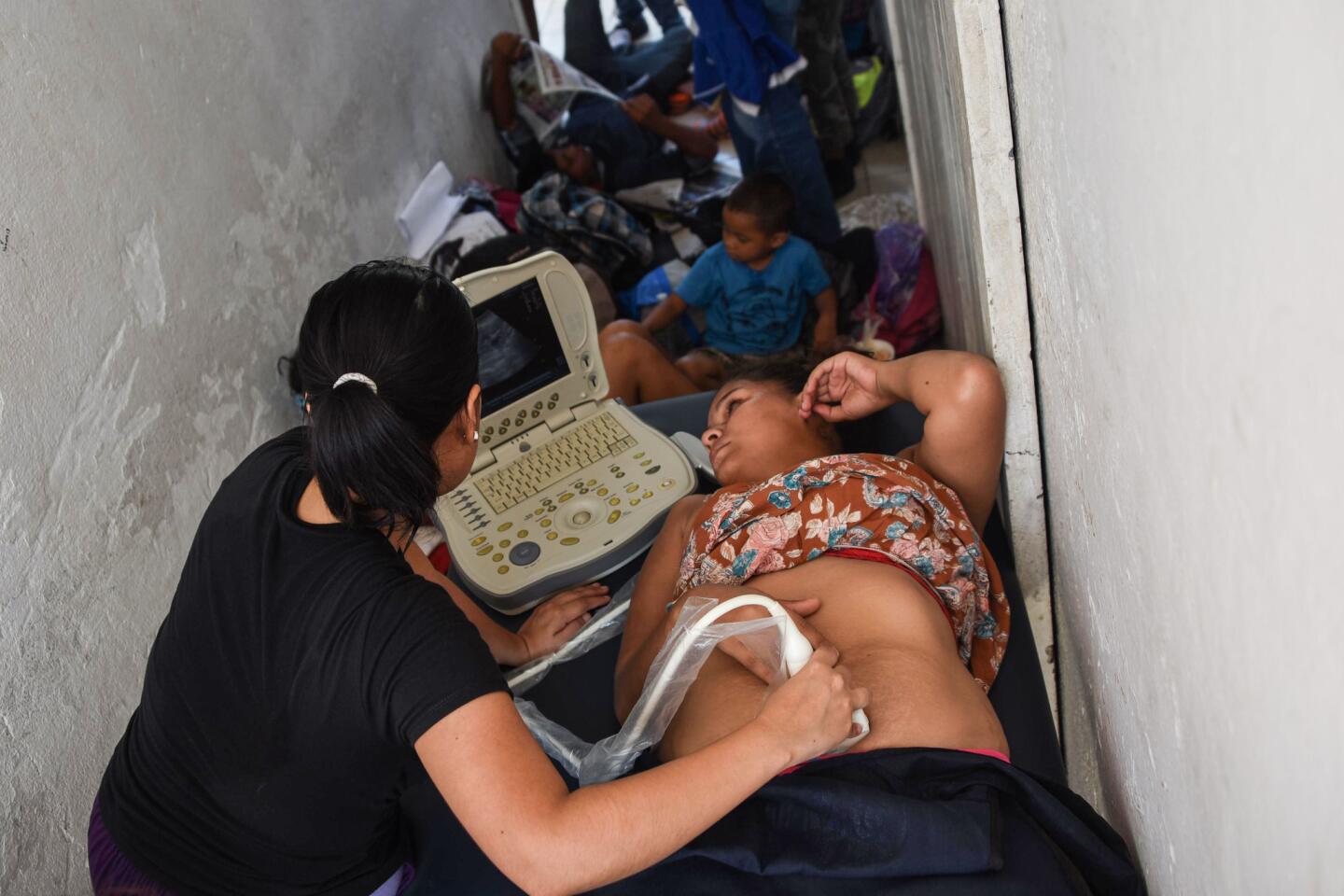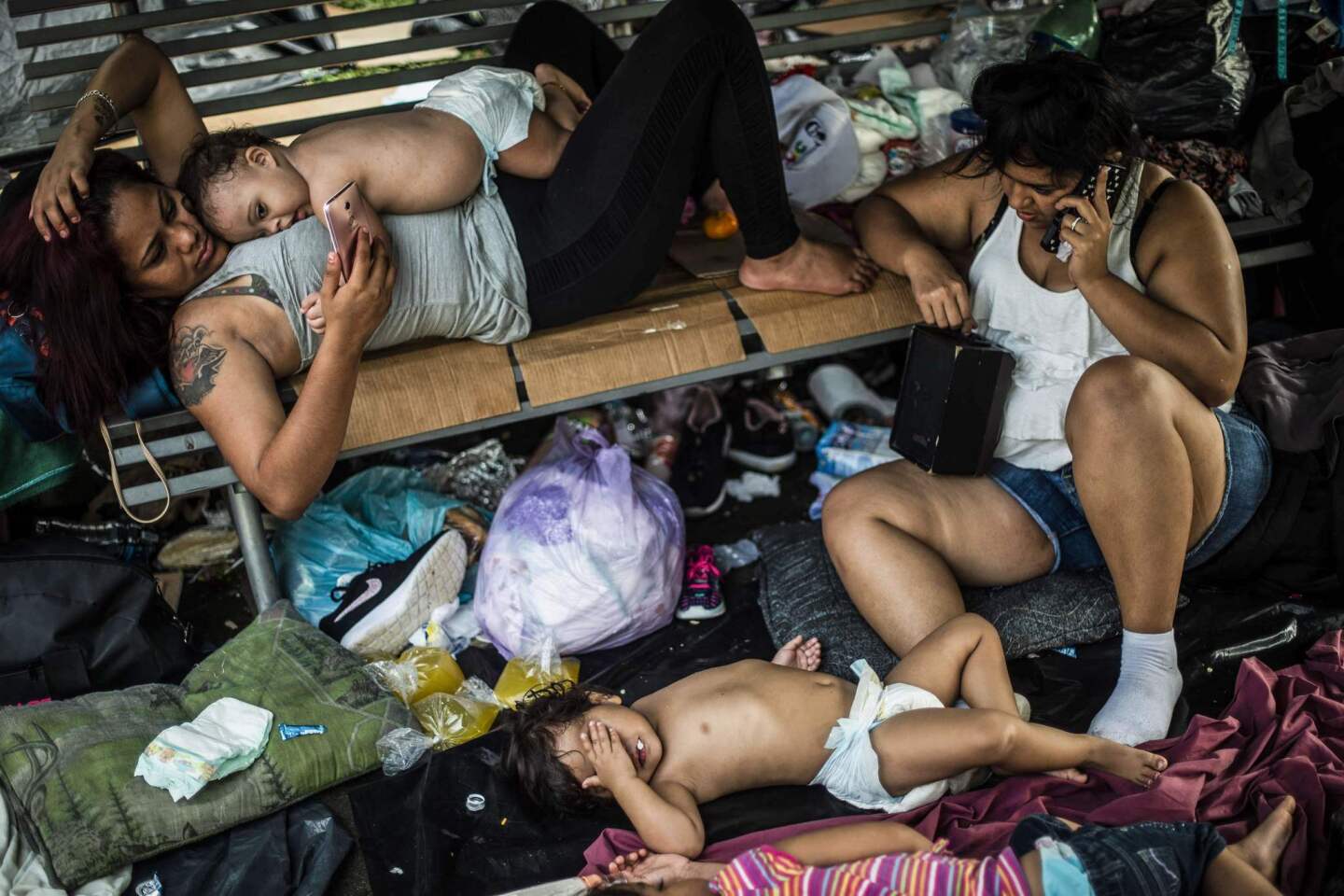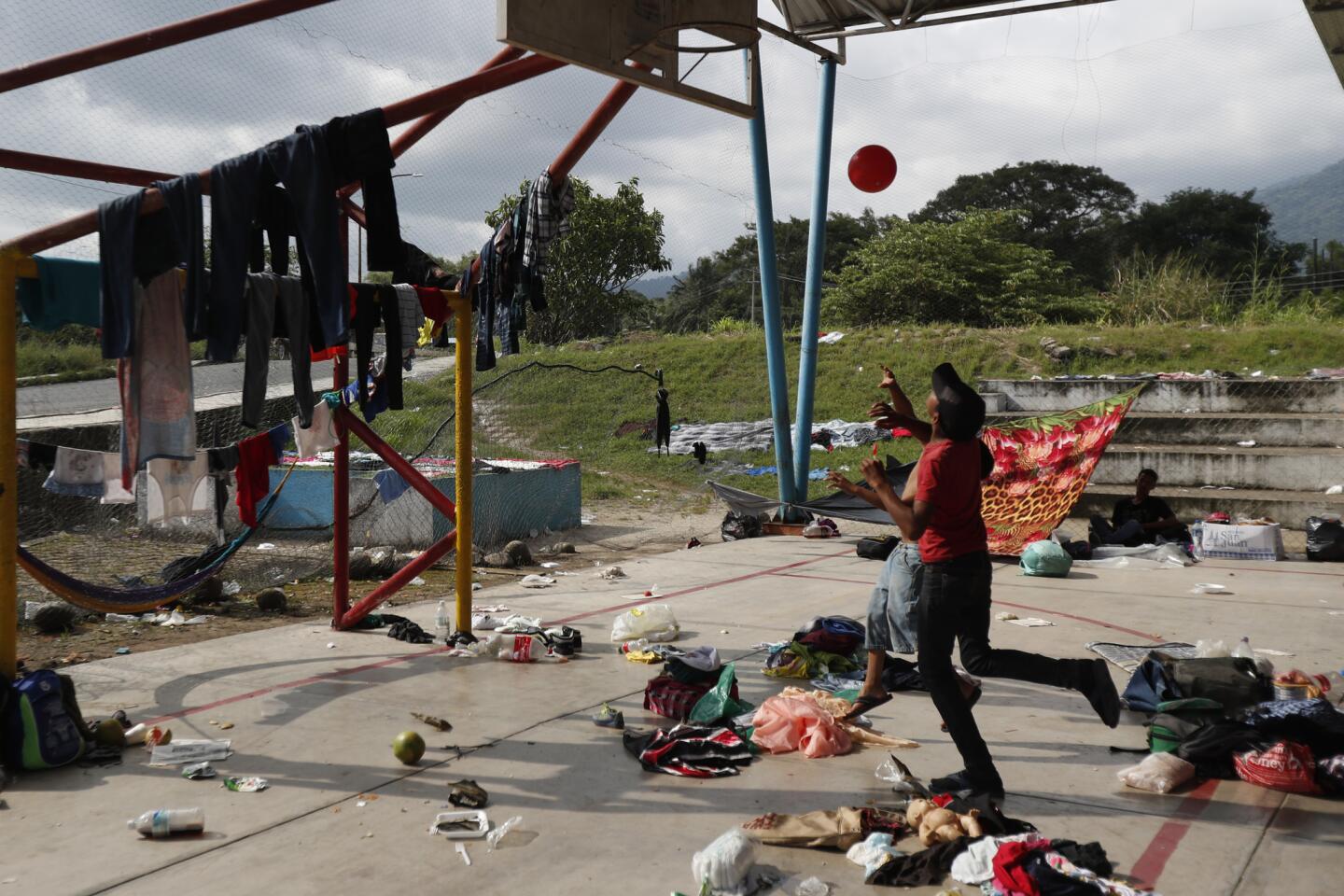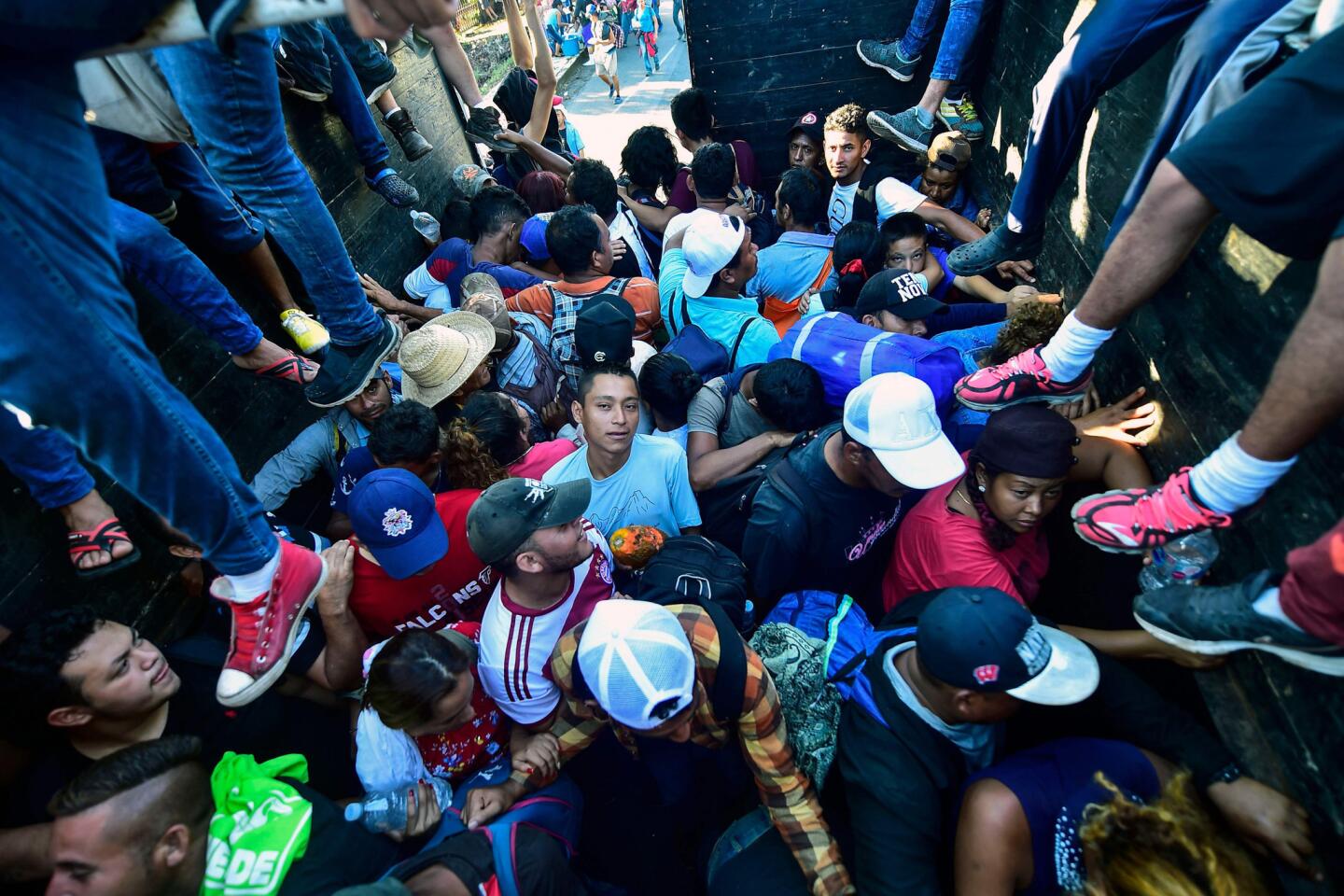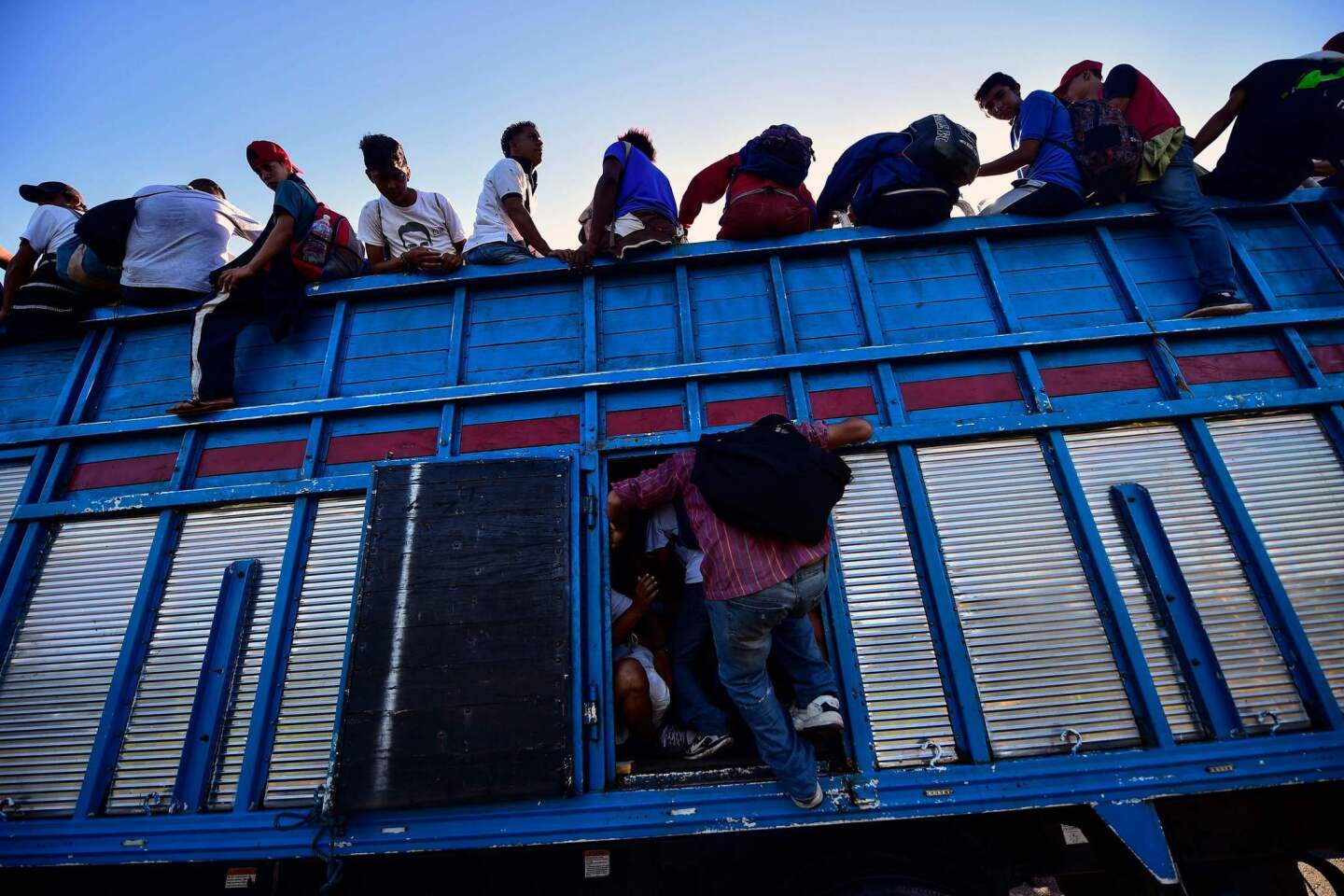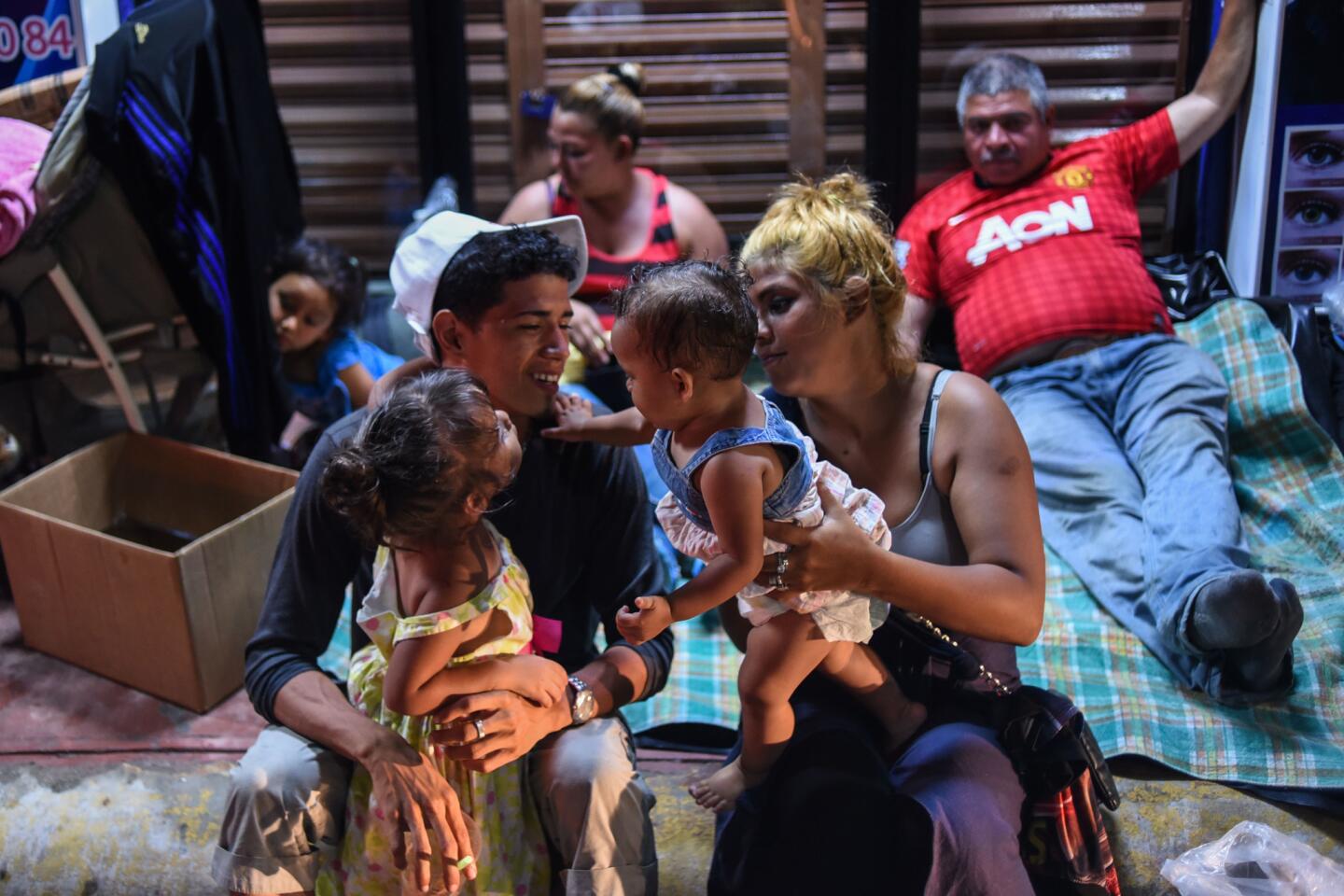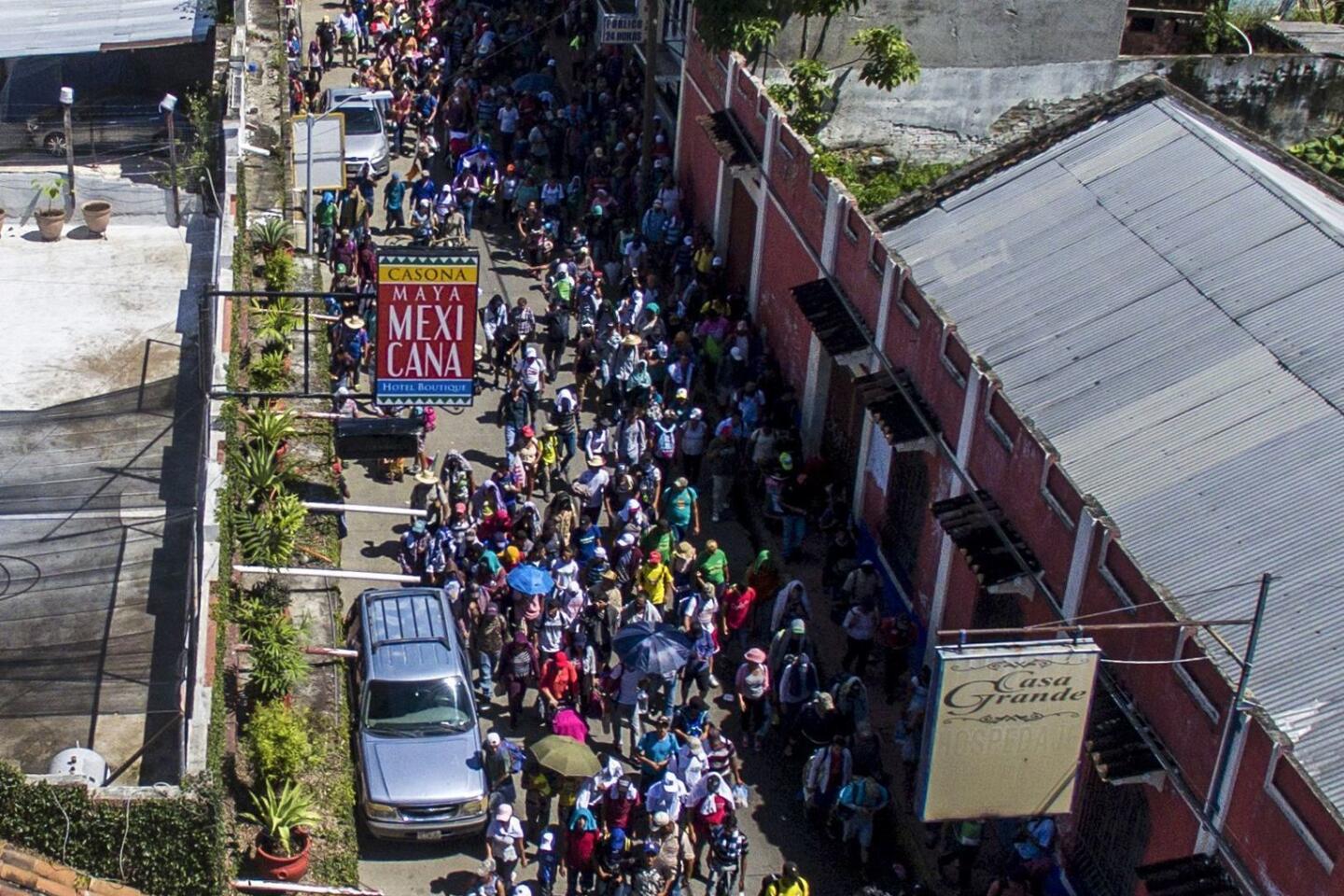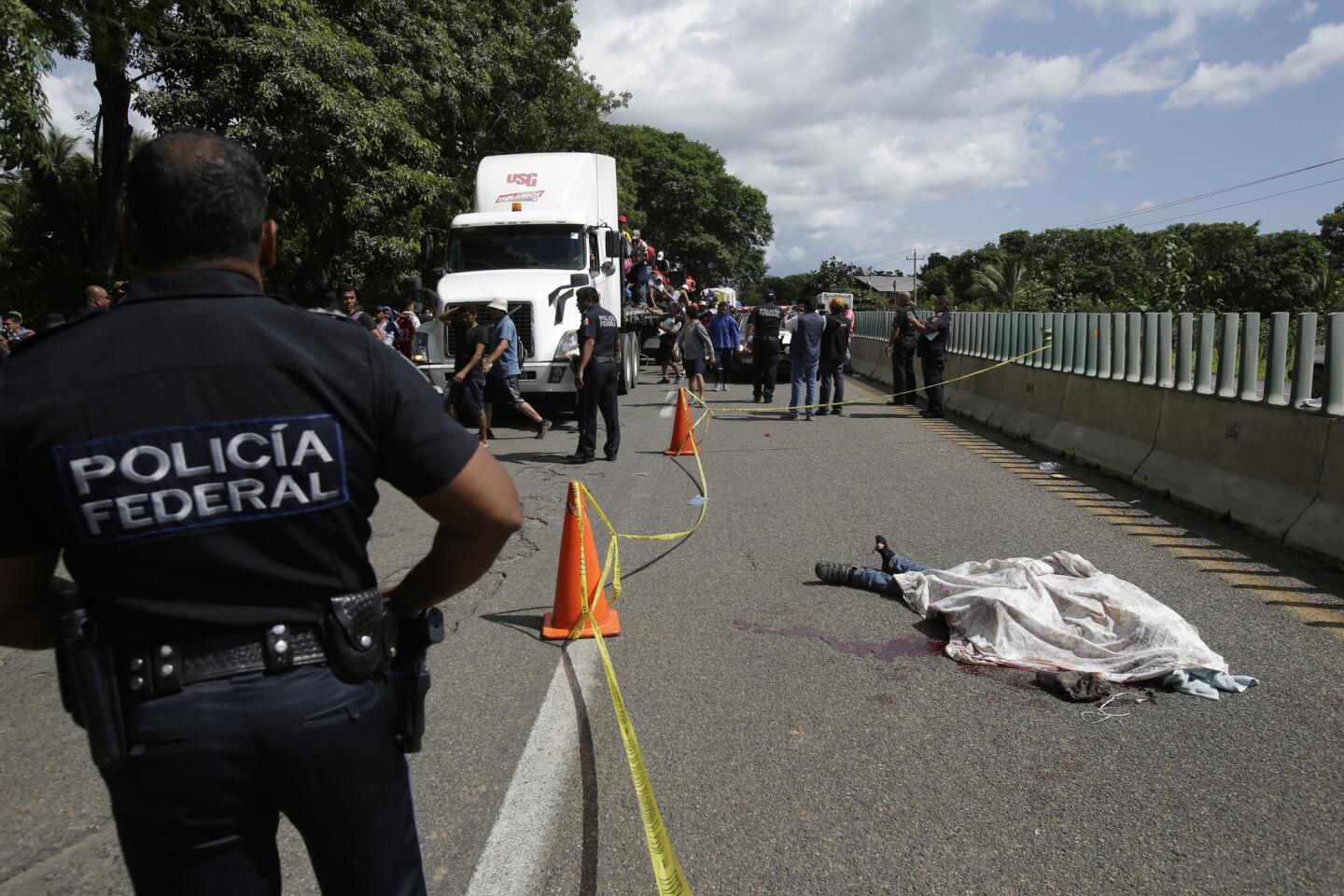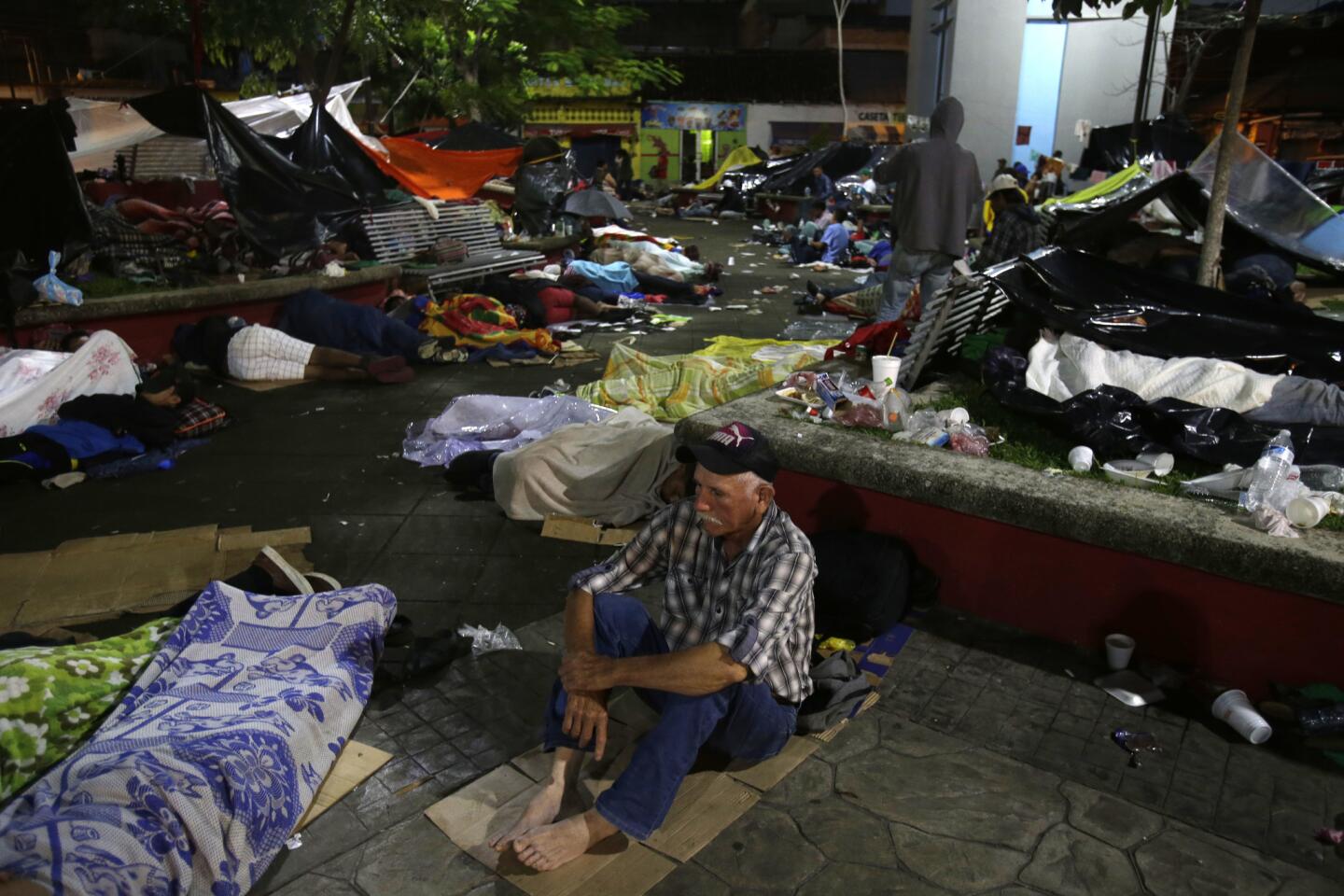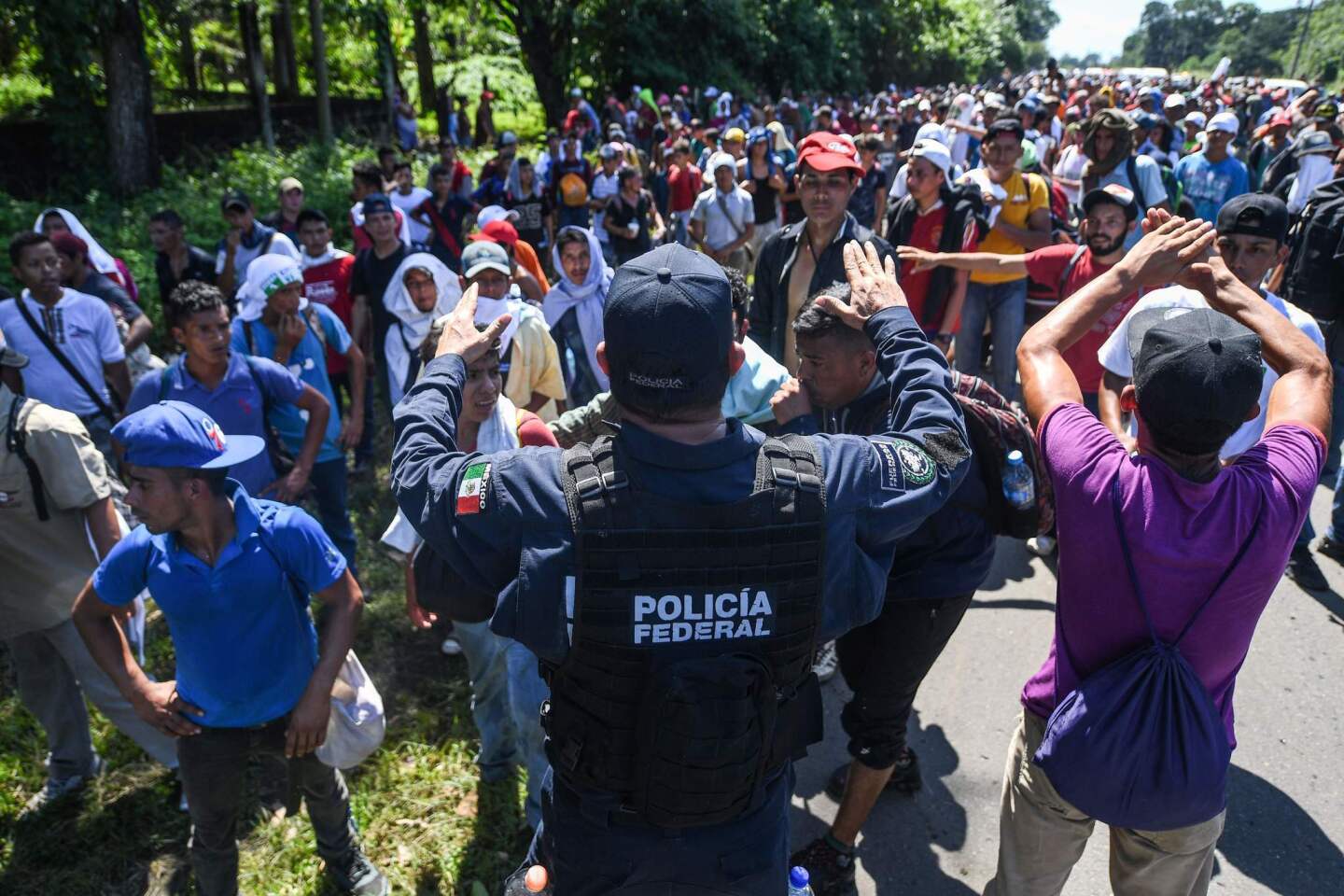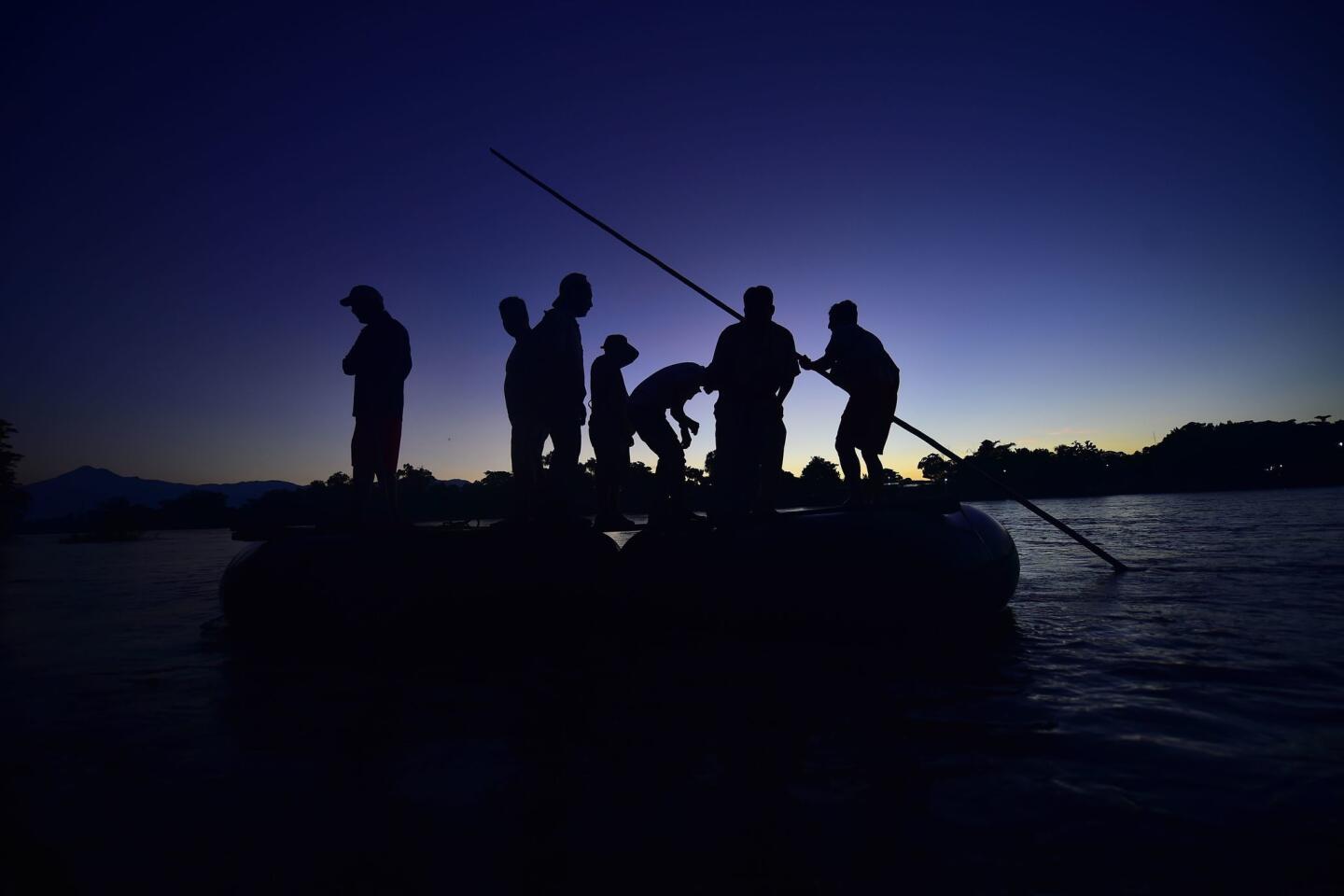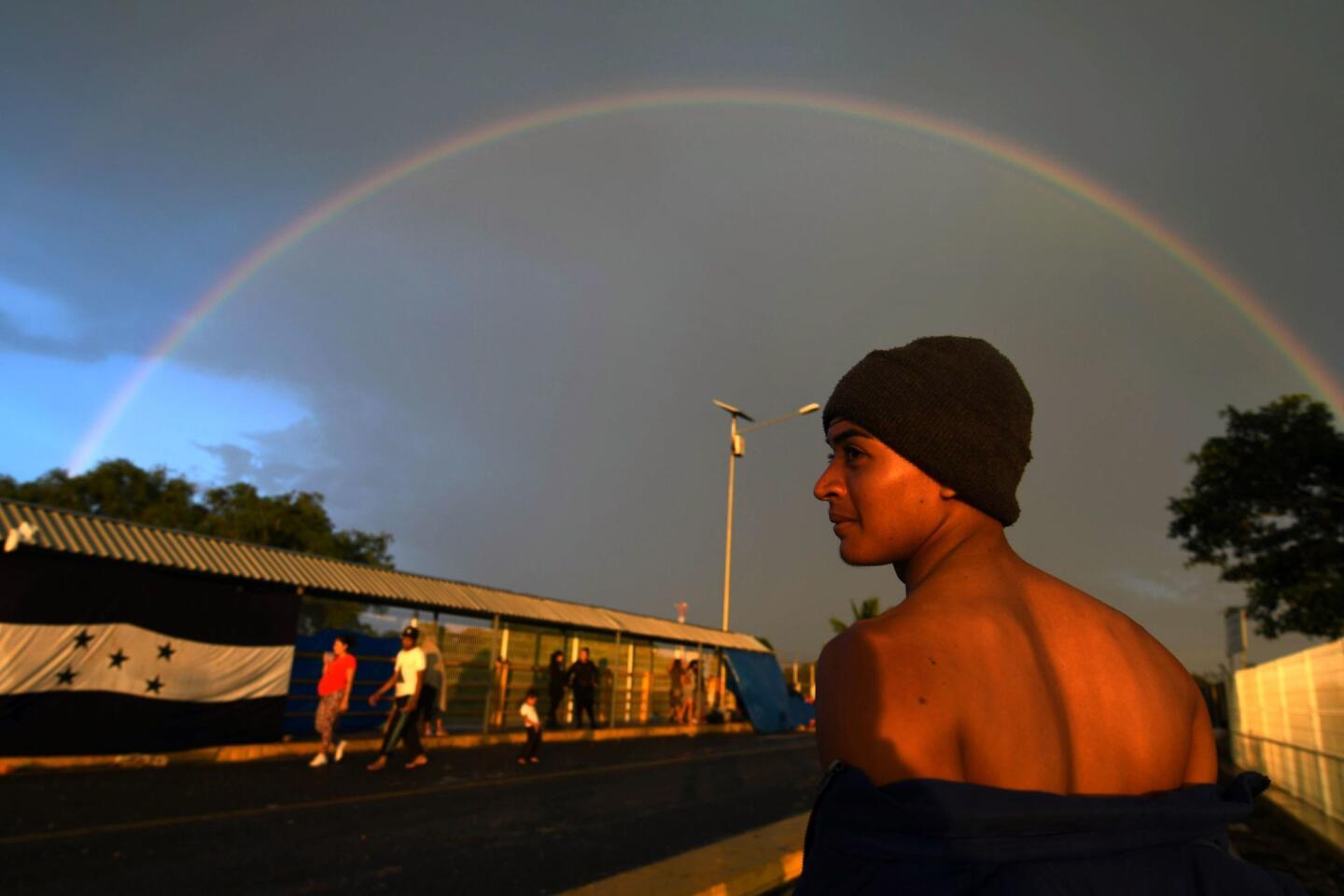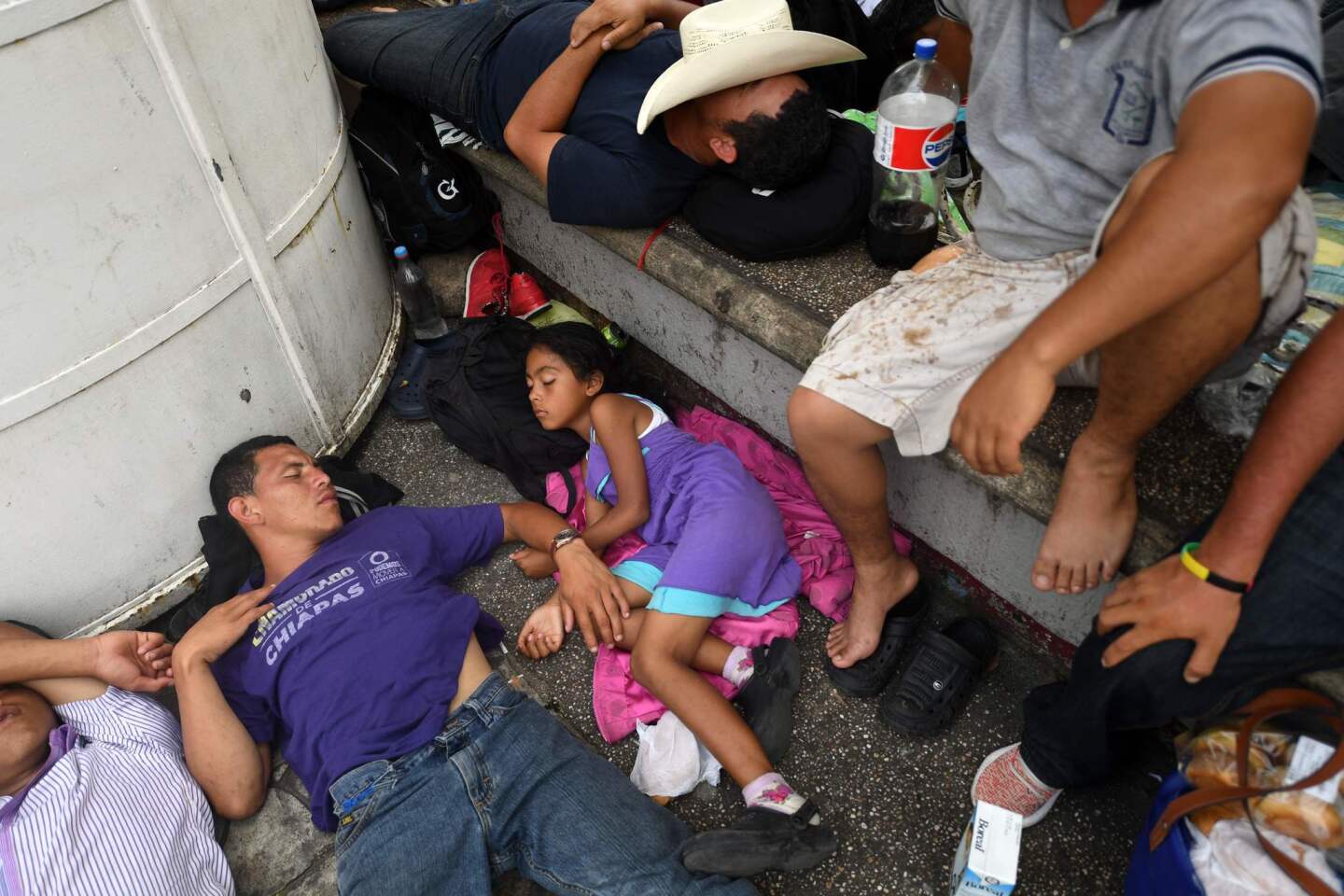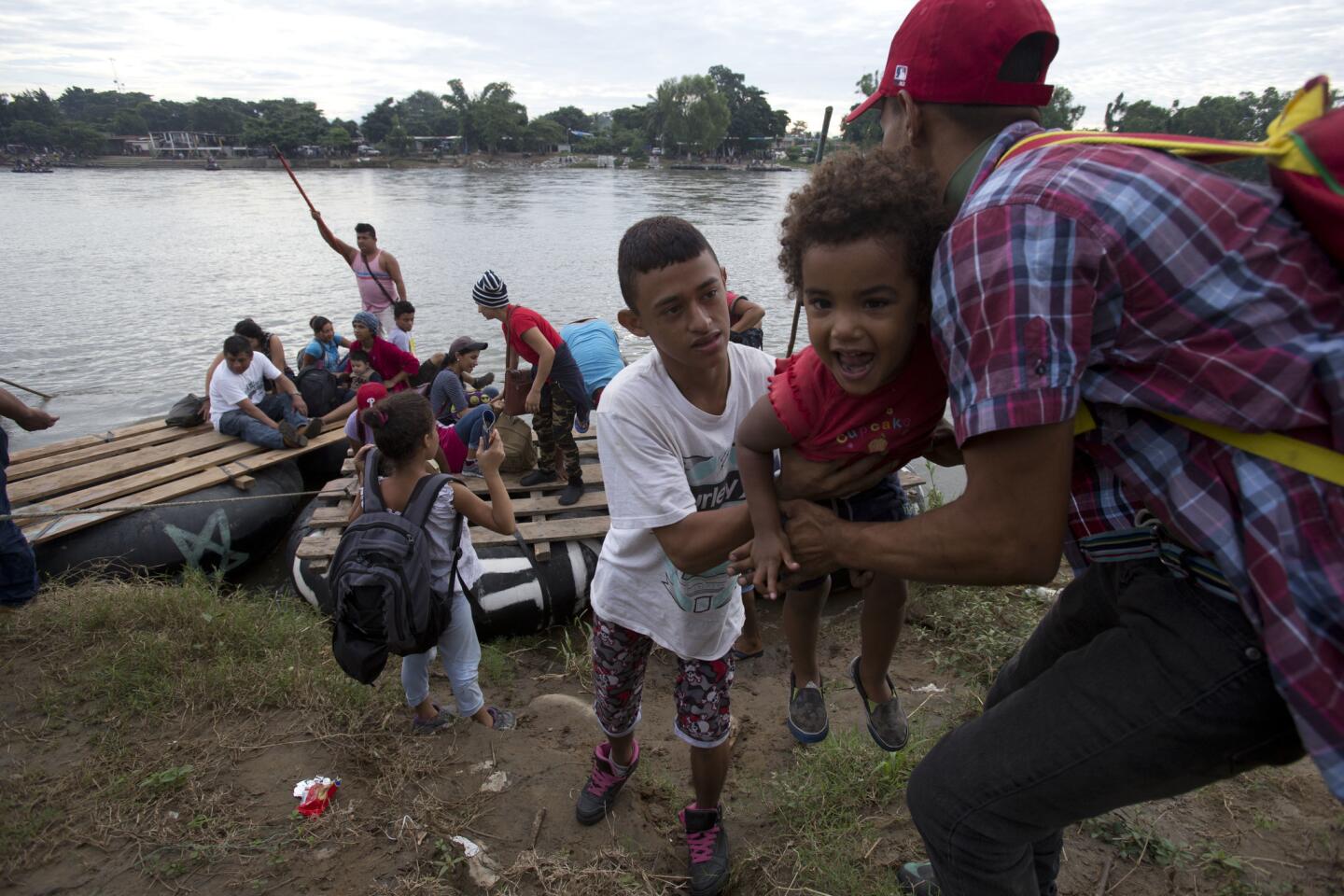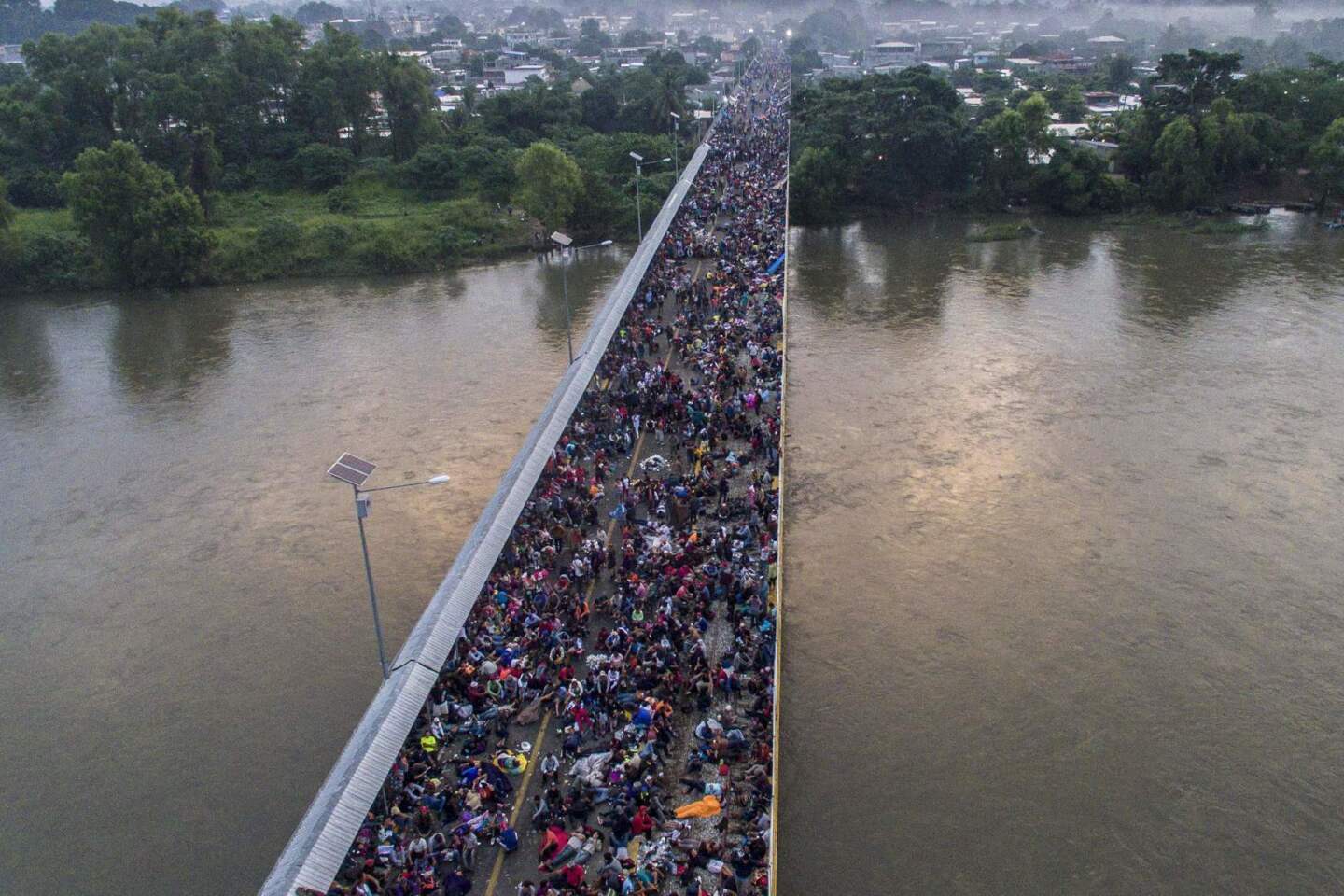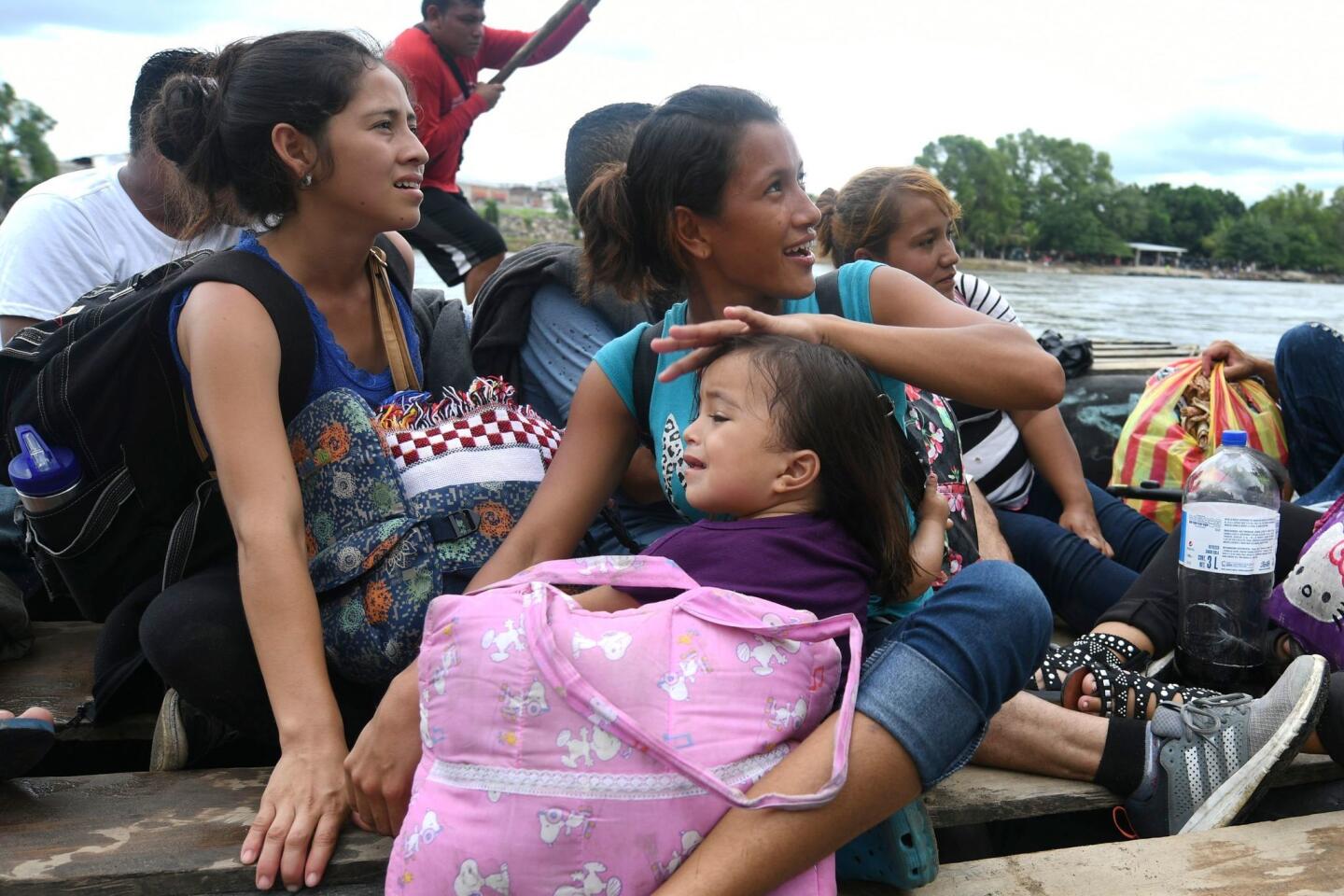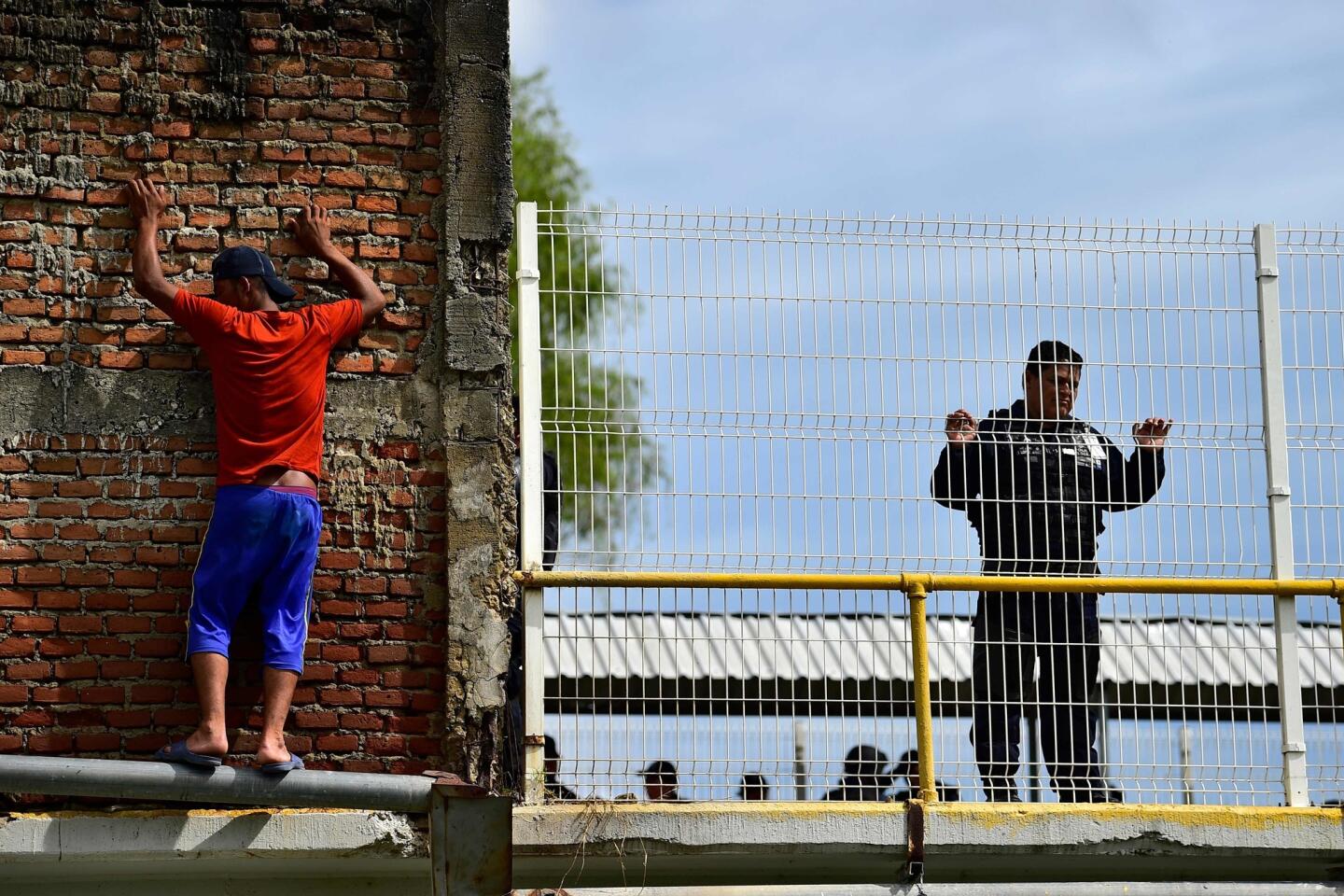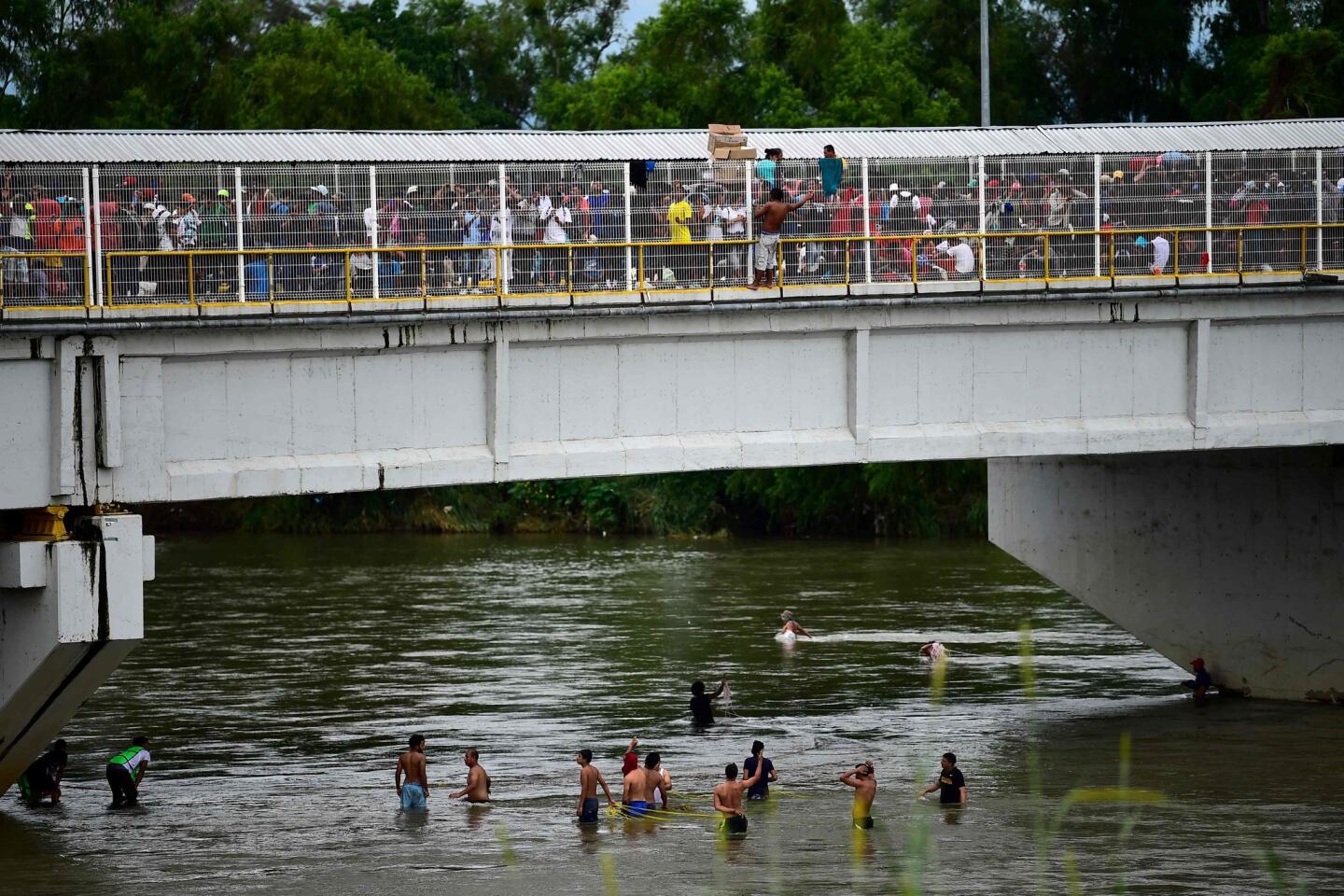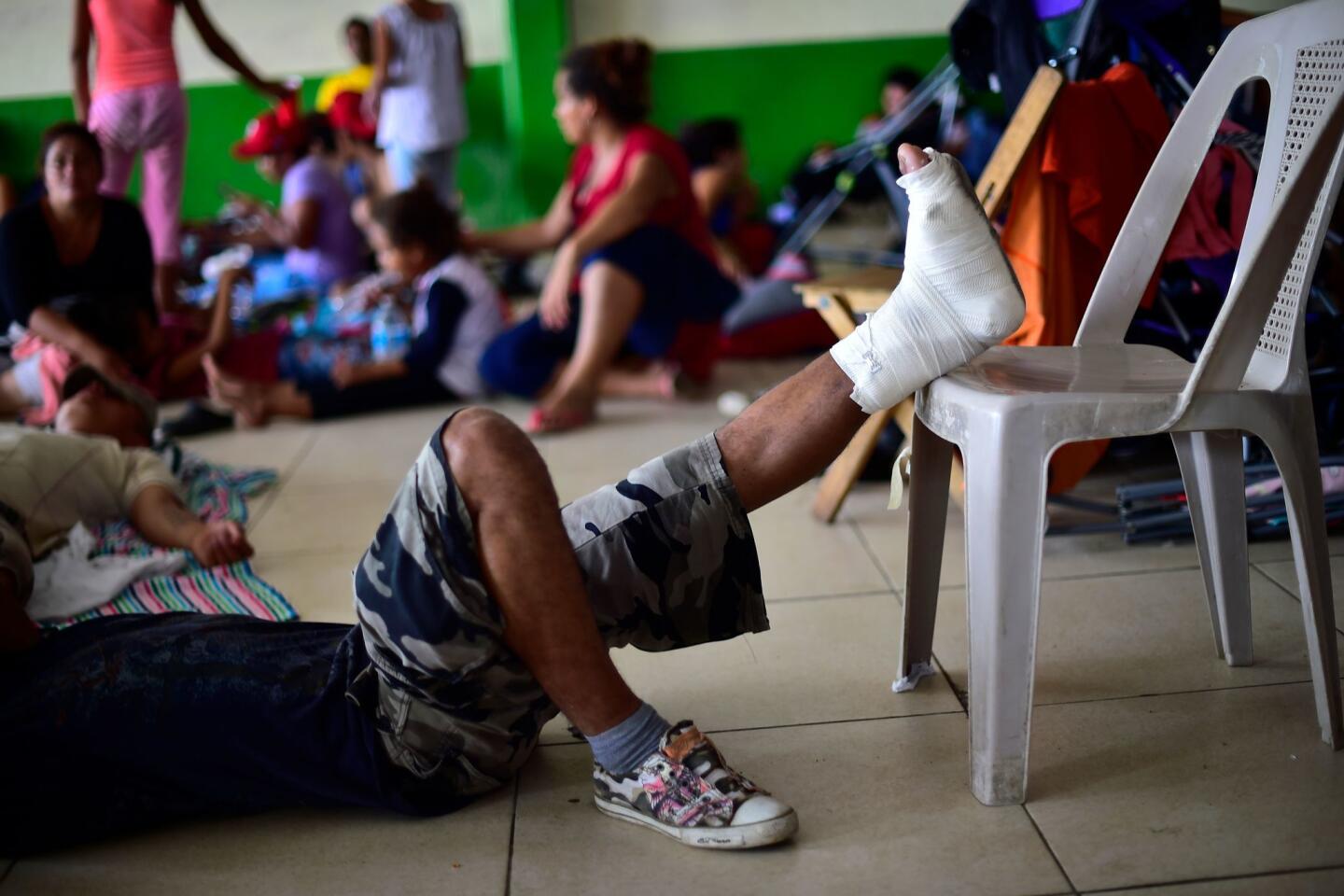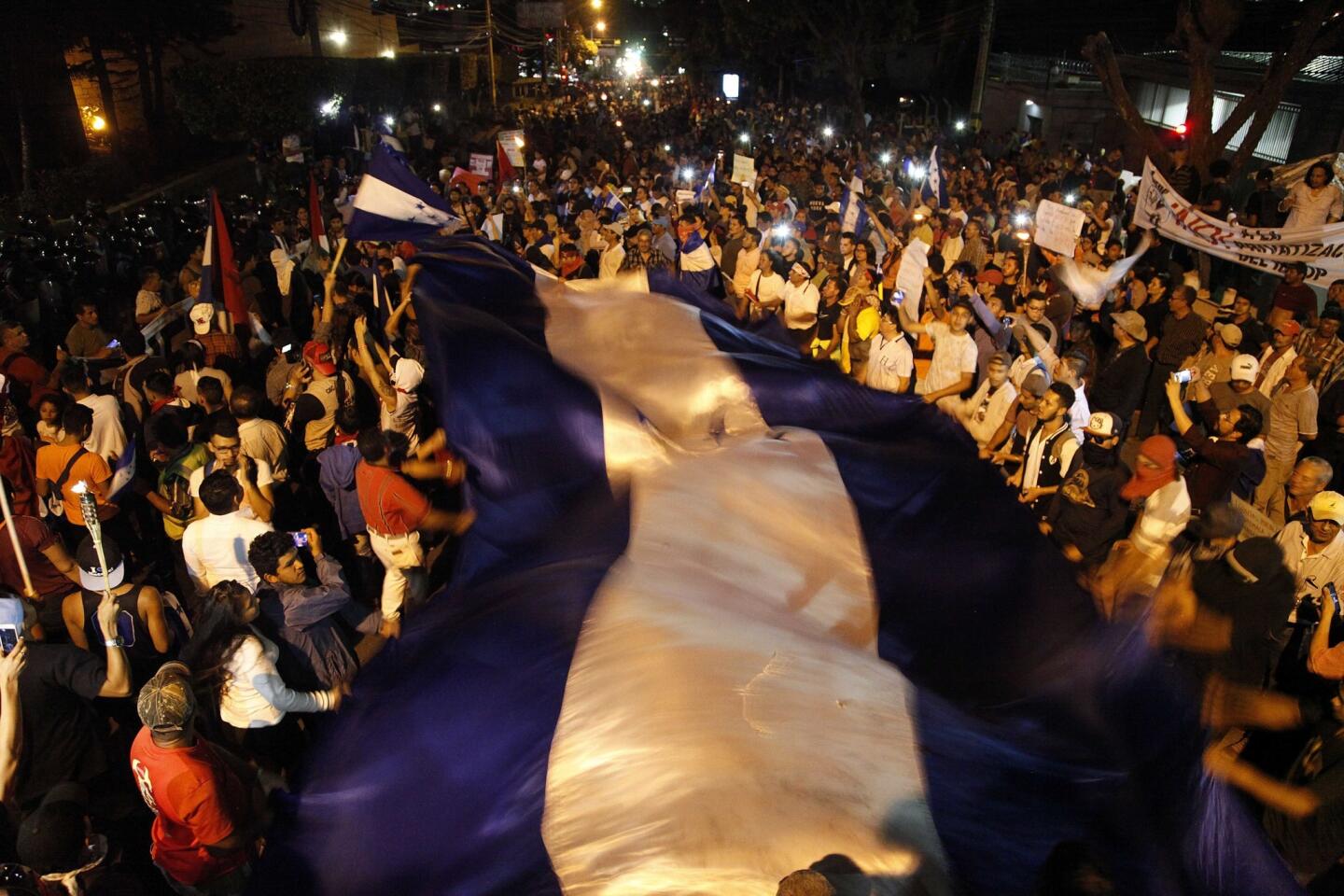Trump prepares plan to close border to Central American migrants and deploy troops
- Share via
Reporting from Washington — Fixated on the migrant caravan moving north through Mexico, President Trump is weighing a plan to shut the U.S. border to Central Americans and deny them the opportunity to seek asylum, asserting similar emergency powers used during the travel ban first issued in early 2017, according to administration officials and other people familiar with the proposal.
The White House is also preparing to deploy as many as 1,000 additional U.S. troops to assist in security operations at the border in anticipation of the caravan’s arrival, officials said.
Under U.S. law, foreign nationals fleeing persecution have the right to apply for asylum once they reach American soil, but the executive order under consideration would suspend that provision and bar Central Americans as a matter of national security, according to those familiar with the proposal.
Such a move would probably trigger immediate challenges in U.S. courts.
With the midterm election less than two weeks away, Trump has seized on the migrant caravan as a vehicle for his own campaign messaging, depicting the Central American families fleeing violence as dangerous criminals and Democrats as their enablers.
According to a draft of the proposed rule reviewed by the Washington Post, the administration argues that the president can use his authority under Section 212(f) of the Immigration and Nationality Act to declare migrants ineligible for asylum because it “would be contrary to the national interest” and “detrimental to the interests of the United States.”
The section is the same legal authority he invoked during the travel ban.
Several administration officials cautioned that the proposal was not yet finalized and was one of several measures under consideration. Taken together, they could help physically and legally fortify the southern border in anticipation of the arrival of large numbers of migrants Trump characterizes as a threat.
“The administration is considering a wide range of administrative, legal and legislative options to address the Democrat-created crisis of mass illegal immigration,” said a White House official, who spoke on condition of anonymity to discuss sensitive internal discussions. “No decisions have been made at this time,” the official said. “Nor will we forecast to smugglers or caravans what precise strategies will or will not be deployed.”
Said another administration official, when asked about a possible ban on Central Americas, “Everything is on the table.”
The additional troops would reinforce the 2,000 or so National Guard personnel deployed to the border since April. Under a Pentagon order that could be issued as soon as Friday, they would not make arrests or operate in an enforcement role, according to officials with knowledge of the plan.
The migrant caravan remains more than 900 miles from U.S. territory and has dwindled by half to about 3,600 people, according to the latest estimates from Mexican authorities. But the scenes of young men breaking through gates along the Guatemala-Mexico border this month have alarmed the White House, and Trump continues to depict the Central American migrants as a criminal menace and a security threat.
Impoverished families, many of whom are traveling with children and surviving on handouts, compose the bulk of those advancing slowly through southern Mexico.
The Trump administration has provided no evidence that “Middle Easterners” and dangerous criminals are mixed in, as it claims.
One potential problem with the border entry ban under consideration is that migrants who cross illegally would still have to be taken into U.S. custody. The administration could attempt to deny them access to U.S. courts and expedite their deportation, but those migrants would have to be returned to Central America, unless the Mexican government were to agree to take them.
Any attempt to force Mexico to take the Central Americans back would risk “potentially major conflict” with its government, said one Department of Homeland Security official familiar with some of the policy proposals that have been under discussion.
The United States has the legal authority to return them “since they let them through in the first place,” the person said.
In recent weeks, record numbers of migrant family members have streamed across the border in the Rio Grande Valley of south Texas and into southern Arizona, overwhelming detention capacity and prompting mass releases.
U.S. courts have limited the government’s ability to hold children in immigration detention facilities, so “banning” Central Americans who enter illegally could have little practical effect. A denial of their ability to seek asylum could also matter little. Less than 10% of Central American applicants are granted asylum by U.S. immigration judges, according to the latest statistics, but many have used the process as a way to gain entry to the United States and remain in the country while their claims slowly proceed through the legal system.
White House officials have put escalating pressure on the Mexican government to stop the caravan, but officials there have declined to block its advance by force.
In a Thursday morning tweet, Trump called again for changes to U.S. immigration laws, which he said “make it tough for us to stop people at the Border.” He added that he is “bringing out the military for this National Emergency. They will be stopped!”
Later, the president tweeted: “To those in the Caravan, turnaround, we are not letting people into the United States illegally. Go back to your Country and if you want, apply for citizenship like millions of others are doing!”
The caravan is still weeks from reaching the U.S. border, and Mexican authorities said the number of migrants has decreased rapidly, from an estimate of 7,200 by the United Nations early in the week to 3,630 on Wednesday. The Mexican government said it had processed 1,700 asylum claims.
It is not clear what impact the additional military personnel would have, given that many of the migrants, if they reach the United States, would probably attempt to surrender to Border Patrol agents. U.S. officials said the troops would not conduct direct law enforcement but would instead play supporting roles. Those duties were still being defined but are likely to include engineers who can oversee construction and aviation support, and possibly doctors or lawyers who can assist migrants.
Critics have said that a military solution would be costly and ineffective, and they accused Trump of trying to fan public fears over inflated security threats of the caravan to stoke his conservative base ahead of the Nov. 6 midterm election.
“It’s sad and irresponsible that the president would deploy the world’s strongest military against a group of unarmed migrants, including women and children,” said Kevin Appleby, a policy director at the Center for Migration Studies. “It demonstrates that the administration’s deterrence policies have failed and they are at the point of desperation in their immigration policies. They need a new approach, one that addresses regional challenges and the push factors from the [Central American] region. It’s a waste of taxpayer money.”
The addition of active-duty forces could raise concerns among human rights groups, given that the caravan, which originated in Honduras, is made up largely of families, including children. U.S. officials said the additional U.S. forces are not expected to include any “trigger-pullers.”
One U.S. official said the troops’ role will be designed so that the Posse Comitatus Act, a federal law that limits the use of the military for domestic law enforcement operations, is not violated. The official compared the deployment to active-duty troops assisting with hurricane relief.
The National Guard personnel already at the border are under direct orders from their respective state governors and remain under those governors’ control. Defense Secretary James N. Mattis issued a memo this year that prohibited them from interacting directly with “migrants or other persons detained,” and that directive is still in place, said Lt. Col. Dave Eastburn, a Pentagon spokesman.
RJ Hauman, government relations director at the Federation for American Immigration Reform, which advocates for lower immigration levels, said Trump deserves credit for his administration’s efforts to crack down on unauthorized immigration. But he added that a military solution to the Central American caravan would be “ineffective” and said the administration should focus on trying to get Congress to tighten asylum laws.
In most cases, children and families who apply for asylum are not legally allowed to be detained for more than a few weeks and are released into the United States as they await hearings before immigration judges — a process that could take more than a year because of backlogs.
Trump administration officials said there has been a rapid increase in asylum cases, especially from Central America, in recent years, and they have accused human smugglers of coaching immigrants to make false claims of persecution. Immigrant rights groups said the migrants are fleeing gang violence, organized crime and poverty.
“Sending the military down to the border will be ineffective in preventing these organized incursions so long as our asylum and immigration laws can be so easily abused,” Hauman said.
Presidents George W. Bush and Obama both dispatched National Guard troops to assist in border operations. The missions — one from June 2006 to July 2008 and another from June 2010 to September 2011 — cost a total of $1.35 billion, according to a Government Accountability Office report.
The report found that one of the primary benefits of the National Guard was to bridge gaps while new Border Patrol agents were hired and trained. But the report also found that Pentagon officials believed there was no comprehensive strategy at the border and worried about “mission creep” for Guard personnel. Homeland Security officials, meanwhile, expressed concern that the Pentagon assistance was “ad hoc.”
Use of active-duty service members has been especially sensitive since 1997, when a Marine on a drug surveillance mission shot and killed a high school student in the border village of Redford, Texas. The shooter and other Marines present were investigated, but no charges were brought against them. The U.S. government ultimately agreed to pay a $1.9-million settlement to the student’s family.
This year, the Pentagon has examined providing space to other federal agencies to run camps for migrants on specific military bases, and it said in a June memo to Congress that it would prepare to house up to 20,000 unaccompanied migrant children on bases in coming months.
That plan would have similarities to 2014, when the Obama administration housed about 7,000 unaccompanied children on three military bases. But to date, the U.S. government has not moved forward with opening any camps on military bases.
More to Read
Get the L.A. Times Politics newsletter
Deeply reported insights into legislation, politics and policy from Sacramento, Washington and beyond. In your inbox twice per week.
You may occasionally receive promotional content from the Los Angeles Times.
